Transformational Leadership Styles
VerifiedAdded on 2022/09/13
|21
|5573
|14
AI Summary
Contribute Materials
Your contribution can guide someone’s learning journey. Share your
documents today.
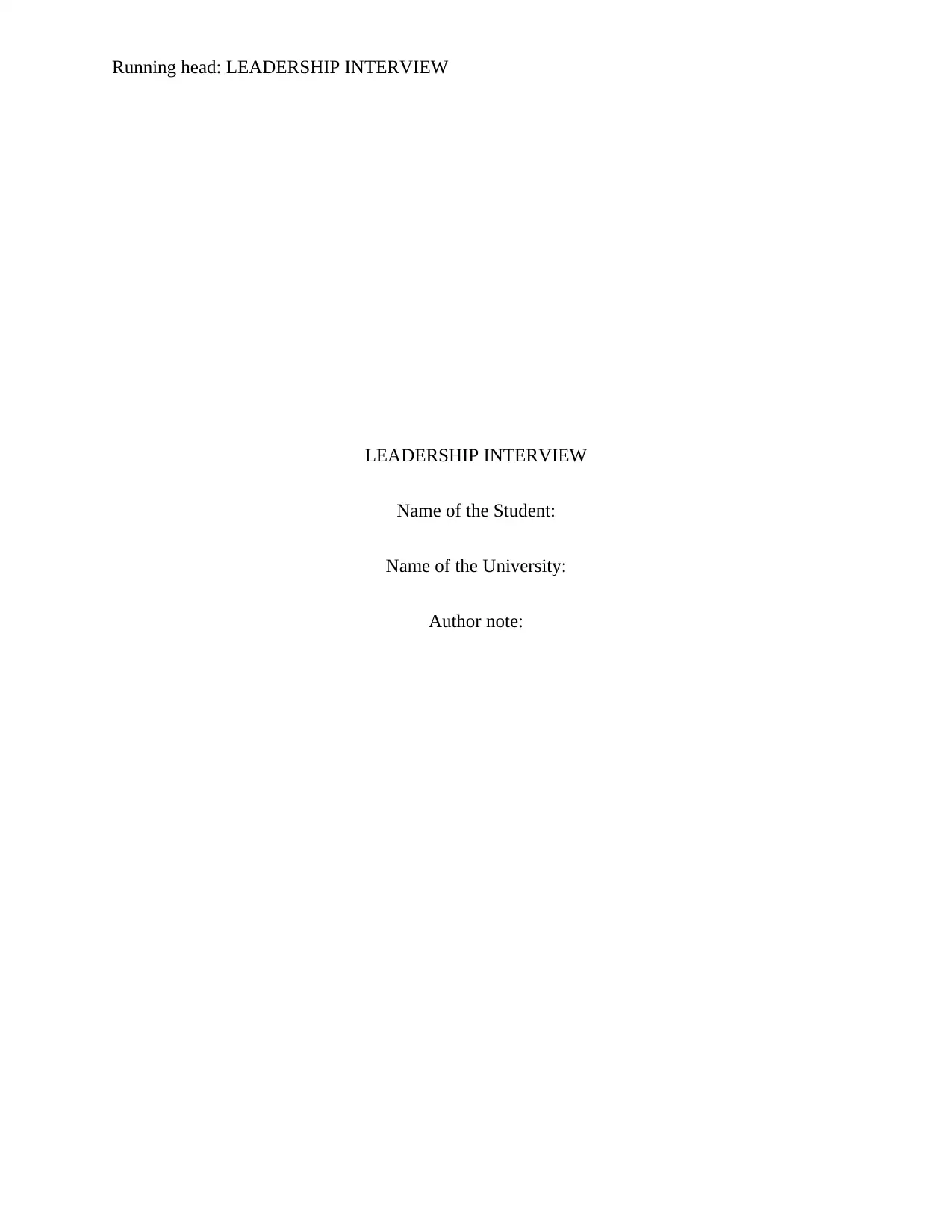
Running head: LEADERSHIP INTERVIEW
LEADERSHIP INTERVIEW
Name of the Student:
Name of the University:
Author note:
LEADERSHIP INTERVIEW
Name of the Student:
Name of the University:
Author note:
Secure Best Marks with AI Grader
Need help grading? Try our AI Grader for instant feedback on your assignments.

1LEADERSHIP INTERVIEW
Introduction
Though there exist a number of comprehensive definitions, in simple terms, leadership
can be defined as the act of guiding and directing followers of a team or organization for the
collective fulfilment of organizational objectives (Bolman and Deal 2017). There exist a number
of theories, styles and models guiding leaders on effective strategies with which leadership can
be practiced. However, theoretical knowledge may differ from practical application – due to
which, the implementation of an interview with a real life leader was useful and thus have been
outlined in the following sections. Practical leadership practice generally comprise of not one but
several leadership theories and styles in conjunction (Grint et al. 2016). Thus some of the key
leadership theories which have been considered for exploration include: transformational,
situational and servant styles of leadership.
Thus, with respect to the above, the following paper will provide an extensive and
elaborate discussion on the significant responses which were identified during an interview with
a manager as well as the ways in which these key responses can be correlated with notable
leadership styles and theories. In addition to expounding upon application of leadership theory in
practice, this paper will also provide recommendations on future improvements in leadership
practice, which were drawn after critically correlating responses with current evidence based
literature.
Discussion
Summary of Responses
The interview was conducted with a 45 year old healthcare manager heading the
administrative department in a notable healthcare organization and holding an experience of
Introduction
Though there exist a number of comprehensive definitions, in simple terms, leadership
can be defined as the act of guiding and directing followers of a team or organization for the
collective fulfilment of organizational objectives (Bolman and Deal 2017). There exist a number
of theories, styles and models guiding leaders on effective strategies with which leadership can
be practiced. However, theoretical knowledge may differ from practical application – due to
which, the implementation of an interview with a real life leader was useful and thus have been
outlined in the following sections. Practical leadership practice generally comprise of not one but
several leadership theories and styles in conjunction (Grint et al. 2016). Thus some of the key
leadership theories which have been considered for exploration include: transformational,
situational and servant styles of leadership.
Thus, with respect to the above, the following paper will provide an extensive and
elaborate discussion on the significant responses which were identified during an interview with
a manager as well as the ways in which these key responses can be correlated with notable
leadership styles and theories. In addition to expounding upon application of leadership theory in
practice, this paper will also provide recommendations on future improvements in leadership
practice, which were drawn after critically correlating responses with current evidence based
literature.
Discussion
Summary of Responses
The interview was conducted with a 45 year old healthcare manager heading the
administrative department in a notable healthcare organization and holding an experience of
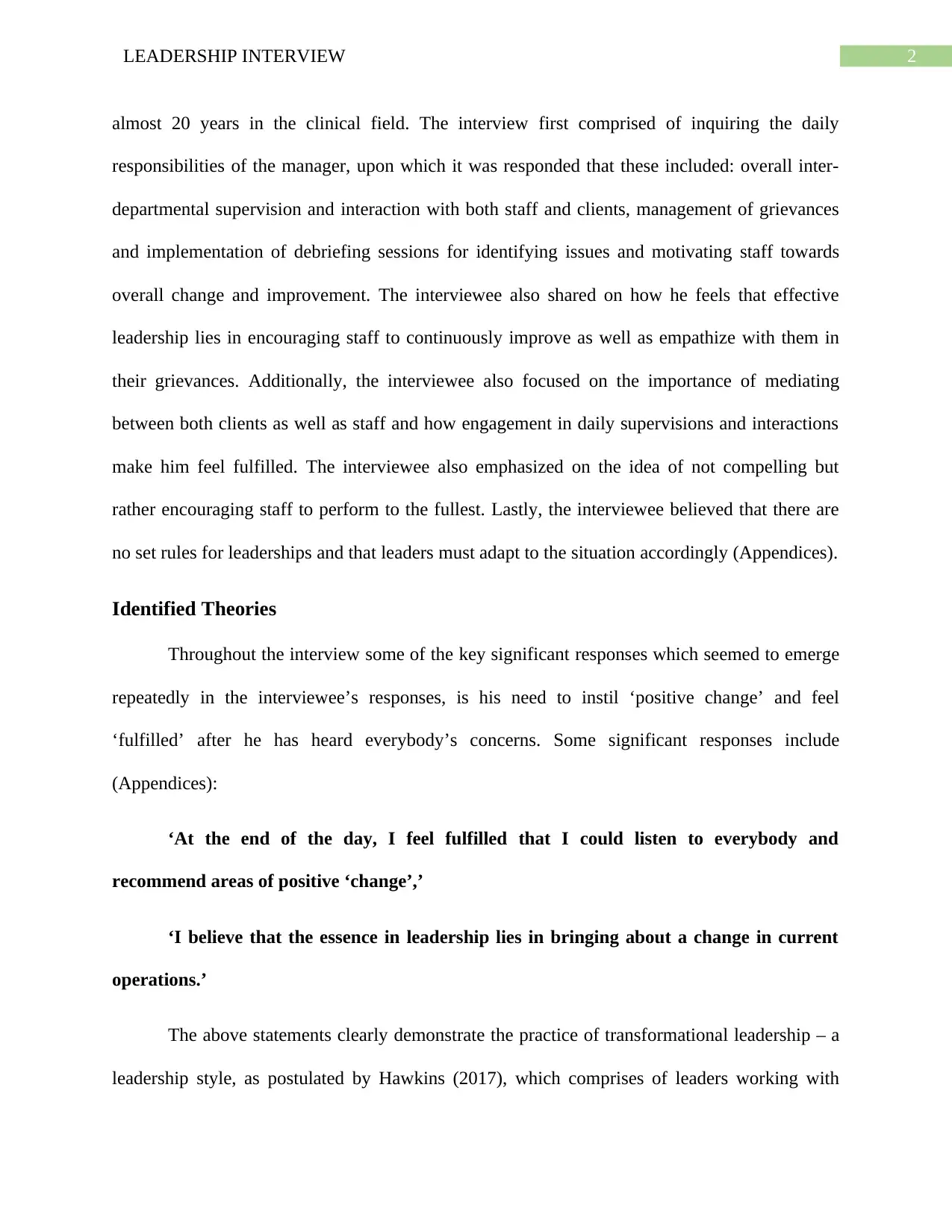
2LEADERSHIP INTERVIEW
almost 20 years in the clinical field. The interview first comprised of inquiring the daily
responsibilities of the manager, upon which it was responded that these included: overall inter-
departmental supervision and interaction with both staff and clients, management of grievances
and implementation of debriefing sessions for identifying issues and motivating staff towards
overall change and improvement. The interviewee also shared on how he feels that effective
leadership lies in encouraging staff to continuously improve as well as empathize with them in
their grievances. Additionally, the interviewee also focused on the importance of mediating
between both clients as well as staff and how engagement in daily supervisions and interactions
make him feel fulfilled. The interviewee also emphasized on the idea of not compelling but
rather encouraging staff to perform to the fullest. Lastly, the interviewee believed that there are
no set rules for leaderships and that leaders must adapt to the situation accordingly (Appendices).
Identified Theories
Throughout the interview some of the key significant responses which seemed to emerge
repeatedly in the interviewee’s responses, is his need to instil ‘positive change’ and feel
‘fulfilled’ after he has heard everybody’s concerns. Some significant responses include
(Appendices):
‘At the end of the day, I feel fulfilled that I could listen to everybody and
recommend areas of positive ‘change’,’
‘I believe that the essence in leadership lies in bringing about a change in current
operations.’
The above statements clearly demonstrate the practice of transformational leadership – a
leadership style, as postulated by Hawkins (2017), which comprises of leaders working with
almost 20 years in the clinical field. The interview first comprised of inquiring the daily
responsibilities of the manager, upon which it was responded that these included: overall inter-
departmental supervision and interaction with both staff and clients, management of grievances
and implementation of debriefing sessions for identifying issues and motivating staff towards
overall change and improvement. The interviewee also shared on how he feels that effective
leadership lies in encouraging staff to continuously improve as well as empathize with them in
their grievances. Additionally, the interviewee also focused on the importance of mediating
between both clients as well as staff and how engagement in daily supervisions and interactions
make him feel fulfilled. The interviewee also emphasized on the idea of not compelling but
rather encouraging staff to perform to the fullest. Lastly, the interviewee believed that there are
no set rules for leaderships and that leaders must adapt to the situation accordingly (Appendices).
Identified Theories
Throughout the interview some of the key significant responses which seemed to emerge
repeatedly in the interviewee’s responses, is his need to instil ‘positive change’ and feel
‘fulfilled’ after he has heard everybody’s concerns. Some significant responses include
(Appendices):
‘At the end of the day, I feel fulfilled that I could listen to everybody and
recommend areas of positive ‘change’,’
‘I believe that the essence in leadership lies in bringing about a change in current
operations.’
The above statements clearly demonstrate the practice of transformational leadership – a
leadership style, as postulated by Hawkins (2017), which comprises of leaders working with
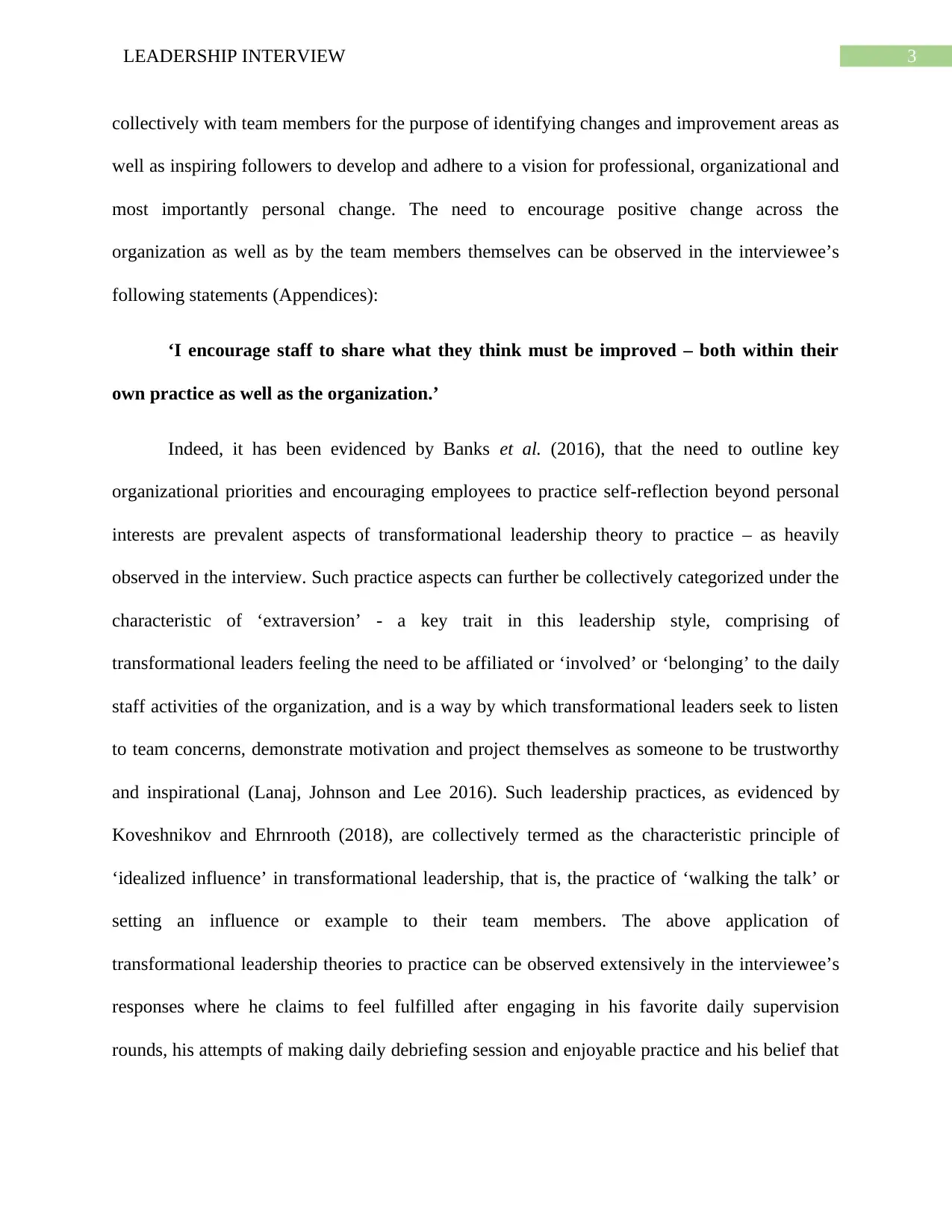
3LEADERSHIP INTERVIEW
collectively with team members for the purpose of identifying changes and improvement areas as
well as inspiring followers to develop and adhere to a vision for professional, organizational and
most importantly personal change. The need to encourage positive change across the
organization as well as by the team members themselves can be observed in the interviewee’s
following statements (Appendices):
‘I encourage staff to share what they think must be improved – both within their
own practice as well as the organization.’
Indeed, it has been evidenced by Banks et al. (2016), that the need to outline key
organizational priorities and encouraging employees to practice self-reflection beyond personal
interests are prevalent aspects of transformational leadership theory to practice – as heavily
observed in the interview. Such practice aspects can further be collectively categorized under the
characteristic of ‘extraversion’ - a key trait in this leadership style, comprising of
transformational leaders feeling the need to be affiliated or ‘involved’ or ‘belonging’ to the daily
staff activities of the organization, and is a way by which transformational leaders seek to listen
to team concerns, demonstrate motivation and project themselves as someone to be trustworthy
and inspirational (Lanaj, Johnson and Lee 2016). Such leadership practices, as evidenced by
Koveshnikov and Ehrnrooth (2018), are collectively termed as the characteristic principle of
‘idealized influence’ in transformational leadership, that is, the practice of ‘walking the talk’ or
setting an influence or example to their team members. The above application of
transformational leadership theories to practice can be observed extensively in the interviewee’s
responses where he claims to feel fulfilled after engaging in his favorite daily supervision
rounds, his attempts of making daily debriefing session and enjoyable practice and his belief that
collectively with team members for the purpose of identifying changes and improvement areas as
well as inspiring followers to develop and adhere to a vision for professional, organizational and
most importantly personal change. The need to encourage positive change across the
organization as well as by the team members themselves can be observed in the interviewee’s
following statements (Appendices):
‘I encourage staff to share what they think must be improved – both within their
own practice as well as the organization.’
Indeed, it has been evidenced by Banks et al. (2016), that the need to outline key
organizational priorities and encouraging employees to practice self-reflection beyond personal
interests are prevalent aspects of transformational leadership theory to practice – as heavily
observed in the interview. Such practice aspects can further be collectively categorized under the
characteristic of ‘extraversion’ - a key trait in this leadership style, comprising of
transformational leaders feeling the need to be affiliated or ‘involved’ or ‘belonging’ to the daily
staff activities of the organization, and is a way by which transformational leaders seek to listen
to team concerns, demonstrate motivation and project themselves as someone to be trustworthy
and inspirational (Lanaj, Johnson and Lee 2016). Such leadership practices, as evidenced by
Koveshnikov and Ehrnrooth (2018), are collectively termed as the characteristic principle of
‘idealized influence’ in transformational leadership, that is, the practice of ‘walking the talk’ or
setting an influence or example to their team members. The above application of
transformational leadership theories to practice can be observed extensively in the interviewee’s
responses where he claims to feel fulfilled after engaging in his favorite daily supervision
rounds, his attempts of making daily debriefing session and enjoyable practice and his belief that
Paraphrase This Document
Need a fresh take? Get an instant paraphrase of this document with our AI Paraphraser

4LEADERSHIP INTERVIEW
a key solution to solving a challenging situation is to seek for scope of future improvement.
These can be observed in the following (Appendices):
‘Next is my favourite part – my supervisory rounds… After lunch I communicate
with the quality control department on issues I identified and then we I engage in
debriefing sessions with my team leaders. At the end of the day, I feel fulfilled that I could
listen to everybody…’
‘Interact! Interact! Interact! That’s why I take debriefing sessions – to identify and
resolve employee issues …… I try to make it as fun and interactive as possible. I goof
around, make them comfortable’
Indeed, transformational leadership style is considered has one of the most effective and
prevalently used theories for instilling multifaceted improvements within the organization as
well as across team members. A transformational leader’s charismatic style of leadership
practice is a key reasons why such leaders can be trusted and are enjoyable to work with
(Zineldin 2017). However, transformational leadership styles are not without limitations and
criticisms. The transformational theory of leadership has been criticized by Fourie and Höhne
(2019), as one which is impulsive and emotional since leaders are almost always focusing on
long term change and on ways in which change can be achieved rather than focusing on current
issues at hand, such as the actual levels of motivation or competencies held by employees.
Transformational leaders are criticized to always expect employees to have the same levels of
motivation and thus, end up placing unrealistic responsibilities on grounds of long term change
(Matjie 2018). While the emphasis on change by transformational leaders is useful for long term
improvement – lack of engaging in an in-depth exploration of employee perceptions can
contribute to burnout, stress, fatigue, frustration, loss of motivation across employees and
a key solution to solving a challenging situation is to seek for scope of future improvement.
These can be observed in the following (Appendices):
‘Next is my favourite part – my supervisory rounds… After lunch I communicate
with the quality control department on issues I identified and then we I engage in
debriefing sessions with my team leaders. At the end of the day, I feel fulfilled that I could
listen to everybody…’
‘Interact! Interact! Interact! That’s why I take debriefing sessions – to identify and
resolve employee issues …… I try to make it as fun and interactive as possible. I goof
around, make them comfortable’
Indeed, transformational leadership style is considered has one of the most effective and
prevalently used theories for instilling multifaceted improvements within the organization as
well as across team members. A transformational leader’s charismatic style of leadership
practice is a key reasons why such leaders can be trusted and are enjoyable to work with
(Zineldin 2017). However, transformational leadership styles are not without limitations and
criticisms. The transformational theory of leadership has been criticized by Fourie and Höhne
(2019), as one which is impulsive and emotional since leaders are almost always focusing on
long term change and on ways in which change can be achieved rather than focusing on current
issues at hand, such as the actual levels of motivation or competencies held by employees.
Transformational leaders are criticized to always expect employees to have the same levels of
motivation and thus, end up placing unrealistic responsibilities on grounds of long term change
(Matjie 2018). While the emphasis on change by transformational leaders is useful for long term
improvement – lack of engaging in an in-depth exploration of employee perceptions can
contribute to burnout, stress, fatigue, frustration, loss of motivation across employees and
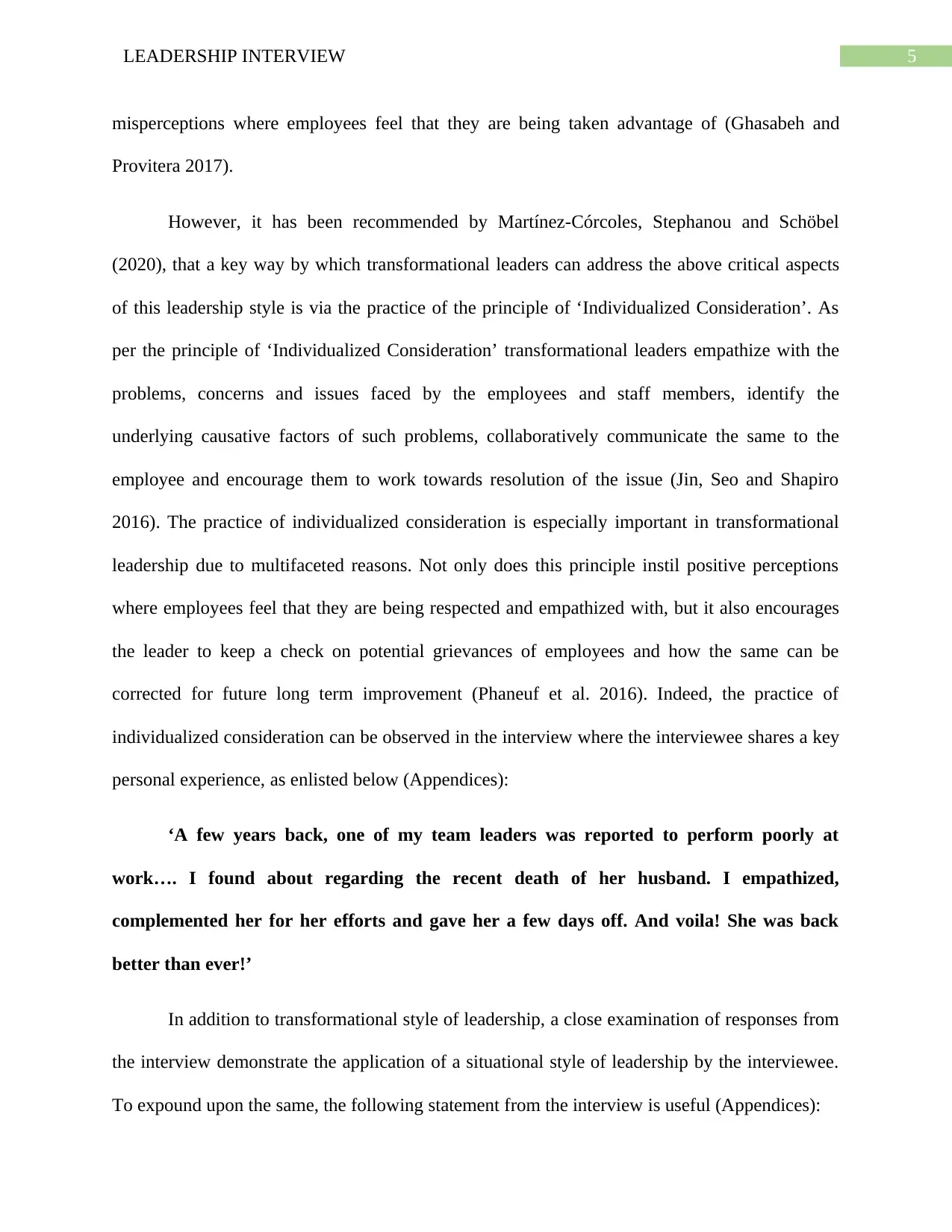
5LEADERSHIP INTERVIEW
misperceptions where employees feel that they are being taken advantage of (Ghasabeh and
Provitera 2017).
However, it has been recommended by Martínez-Córcoles, Stephanou and Schöbel
(2020), that a key way by which transformational leaders can address the above critical aspects
of this leadership style is via the practice of the principle of ‘Individualized Consideration’. As
per the principle of ‘Individualized Consideration’ transformational leaders empathize with the
problems, concerns and issues faced by the employees and staff members, identify the
underlying causative factors of such problems, collaboratively communicate the same to the
employee and encourage them to work towards resolution of the issue (Jin, Seo and Shapiro
2016). The practice of individualized consideration is especially important in transformational
leadership due to multifaceted reasons. Not only does this principle instil positive perceptions
where employees feel that they are being respected and empathized with, but it also encourages
the leader to keep a check on potential grievances of employees and how the same can be
corrected for future long term improvement (Phaneuf et al. 2016). Indeed, the practice of
individualized consideration can be observed in the interview where the interviewee shares a key
personal experience, as enlisted below (Appendices):
‘A few years back, one of my team leaders was reported to perform poorly at
work…. I found about regarding the recent death of her husband. I empathized,
complemented her for her efforts and gave her a few days off. And voila! She was back
better than ever!’
In addition to transformational style of leadership, a close examination of responses from
the interview demonstrate the application of a situational style of leadership by the interviewee.
To expound upon the same, the following statement from the interview is useful (Appendices):
misperceptions where employees feel that they are being taken advantage of (Ghasabeh and
Provitera 2017).
However, it has been recommended by Martínez-Córcoles, Stephanou and Schöbel
(2020), that a key way by which transformational leaders can address the above critical aspects
of this leadership style is via the practice of the principle of ‘Individualized Consideration’. As
per the principle of ‘Individualized Consideration’ transformational leaders empathize with the
problems, concerns and issues faced by the employees and staff members, identify the
underlying causative factors of such problems, collaboratively communicate the same to the
employee and encourage them to work towards resolution of the issue (Jin, Seo and Shapiro
2016). The practice of individualized consideration is especially important in transformational
leadership due to multifaceted reasons. Not only does this principle instil positive perceptions
where employees feel that they are being respected and empathized with, but it also encourages
the leader to keep a check on potential grievances of employees and how the same can be
corrected for future long term improvement (Phaneuf et al. 2016). Indeed, the practice of
individualized consideration can be observed in the interview where the interviewee shares a key
personal experience, as enlisted below (Appendices):
‘A few years back, one of my team leaders was reported to perform poorly at
work…. I found about regarding the recent death of her husband. I empathized,
complemented her for her efforts and gave her a few days off. And voila! She was back
better than ever!’
In addition to transformational style of leadership, a close examination of responses from
the interview demonstrate the application of a situational style of leadership by the interviewee.
To expound upon the same, the following statement from the interview is useful (Appendices):
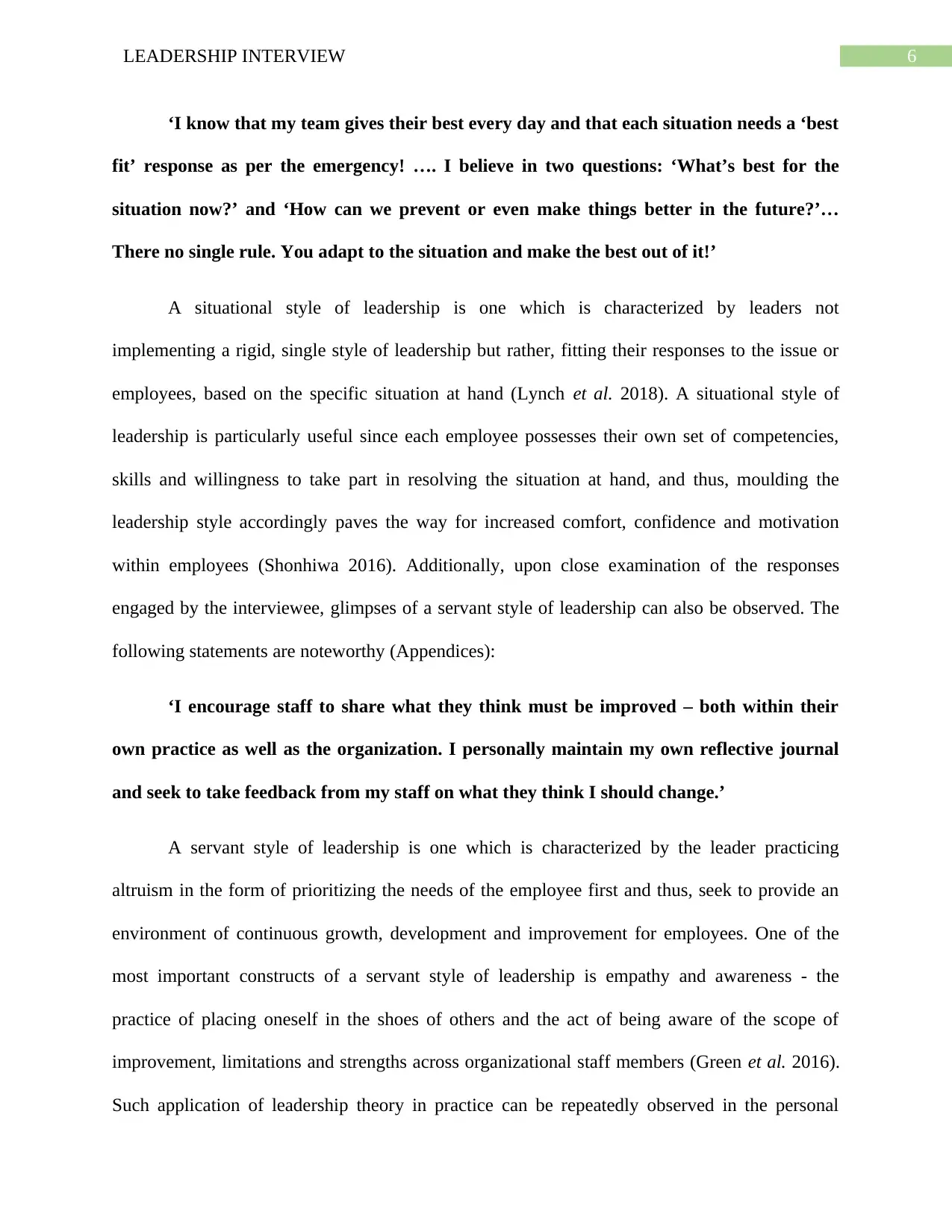
6LEADERSHIP INTERVIEW
‘I know that my team gives their best every day and that each situation needs a ‘best
fit’ response as per the emergency! …. I believe in two questions: ‘What’s best for the
situation now?’ and ‘How can we prevent or even make things better in the future?’…
There no single rule. You adapt to the situation and make the best out of it!’
A situational style of leadership is one which is characterized by leaders not
implementing a rigid, single style of leadership but rather, fitting their responses to the issue or
employees, based on the specific situation at hand (Lynch et al. 2018). A situational style of
leadership is particularly useful since each employee possesses their own set of competencies,
skills and willingness to take part in resolving the situation at hand, and thus, moulding the
leadership style accordingly paves the way for increased comfort, confidence and motivation
within employees (Shonhiwa 2016). Additionally, upon close examination of the responses
engaged by the interviewee, glimpses of a servant style of leadership can also be observed. The
following statements are noteworthy (Appendices):
‘I encourage staff to share what they think must be improved – both within their
own practice as well as the organization. I personally maintain my own reflective journal
and seek to take feedback from my staff on what they think I should change.’
A servant style of leadership is one which is characterized by the leader practicing
altruism in the form of prioritizing the needs of the employee first and thus, seek to provide an
environment of continuous growth, development and improvement for employees. One of the
most important constructs of a servant style of leadership is empathy and awareness - the
practice of placing oneself in the shoes of others and the act of being aware of the scope of
improvement, limitations and strengths across organizational staff members (Green et al. 2016).
Such application of leadership theory in practice can be repeatedly observed in the personal
‘I know that my team gives their best every day and that each situation needs a ‘best
fit’ response as per the emergency! …. I believe in two questions: ‘What’s best for the
situation now?’ and ‘How can we prevent or even make things better in the future?’…
There no single rule. You adapt to the situation and make the best out of it!’
A situational style of leadership is one which is characterized by leaders not
implementing a rigid, single style of leadership but rather, fitting their responses to the issue or
employees, based on the specific situation at hand (Lynch et al. 2018). A situational style of
leadership is particularly useful since each employee possesses their own set of competencies,
skills and willingness to take part in resolving the situation at hand, and thus, moulding the
leadership style accordingly paves the way for increased comfort, confidence and motivation
within employees (Shonhiwa 2016). Additionally, upon close examination of the responses
engaged by the interviewee, glimpses of a servant style of leadership can also be observed. The
following statements are noteworthy (Appendices):
‘I encourage staff to share what they think must be improved – both within their
own practice as well as the organization. I personally maintain my own reflective journal
and seek to take feedback from my staff on what they think I should change.’
A servant style of leadership is one which is characterized by the leader practicing
altruism in the form of prioritizing the needs of the employee first and thus, seek to provide an
environment of continuous growth, development and improvement for employees. One of the
most important constructs of a servant style of leadership is empathy and awareness - the
practice of placing oneself in the shoes of others and the act of being aware of the scope of
improvement, limitations and strengths across organizational staff members (Green et al. 2016).
Such application of leadership theory in practice can be repeatedly observed in the personal
Secure Best Marks with AI Grader
Need help grading? Try our AI Grader for instant feedback on your assignments.
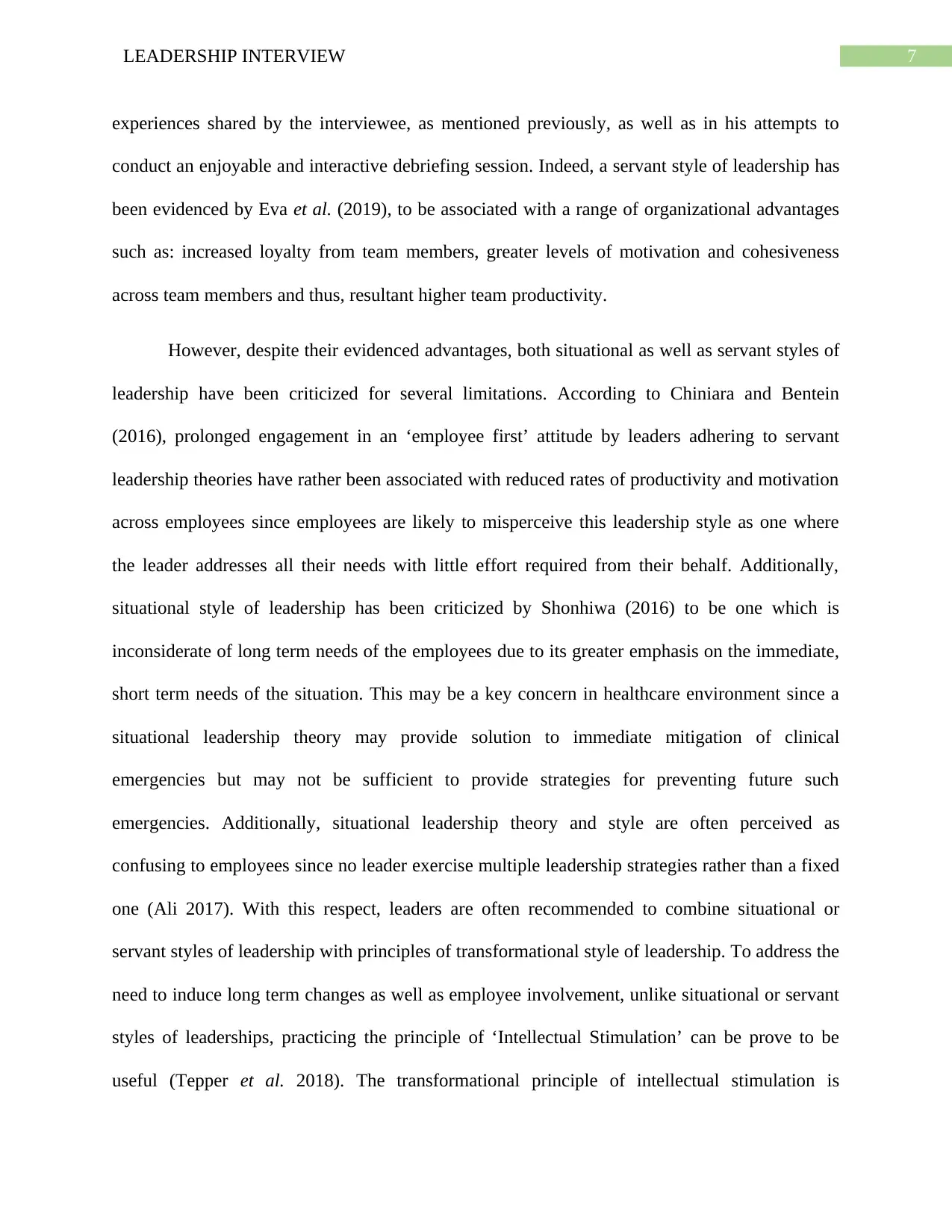
7LEADERSHIP INTERVIEW
experiences shared by the interviewee, as mentioned previously, as well as in his attempts to
conduct an enjoyable and interactive debriefing session. Indeed, a servant style of leadership has
been evidenced by Eva et al. (2019), to be associated with a range of organizational advantages
such as: increased loyalty from team members, greater levels of motivation and cohesiveness
across team members and thus, resultant higher team productivity.
However, despite their evidenced advantages, both situational as well as servant styles of
leadership have been criticized for several limitations. According to Chiniara and Bentein
(2016), prolonged engagement in an ‘employee first’ attitude by leaders adhering to servant
leadership theories have rather been associated with reduced rates of productivity and motivation
across employees since employees are likely to misperceive this leadership style as one where
the leader addresses all their needs with little effort required from their behalf. Additionally,
situational style of leadership has been criticized by Shonhiwa (2016) to be one which is
inconsiderate of long term needs of the employees due to its greater emphasis on the immediate,
short term needs of the situation. This may be a key concern in healthcare environment since a
situational leadership theory may provide solution to immediate mitigation of clinical
emergencies but may not be sufficient to provide strategies for preventing future such
emergencies. Additionally, situational leadership theory and style are often perceived as
confusing to employees since no leader exercise multiple leadership strategies rather than a fixed
one (Ali 2017). With this respect, leaders are often recommended to combine situational or
servant styles of leadership with principles of transformational style of leadership. To address the
need to induce long term changes as well as employee involvement, unlike situational or servant
styles of leaderships, practicing the principle of ‘Intellectual Stimulation’ can be prove to be
useful (Tepper et al. 2018). The transformational principle of intellectual stimulation is
experiences shared by the interviewee, as mentioned previously, as well as in his attempts to
conduct an enjoyable and interactive debriefing session. Indeed, a servant style of leadership has
been evidenced by Eva et al. (2019), to be associated with a range of organizational advantages
such as: increased loyalty from team members, greater levels of motivation and cohesiveness
across team members and thus, resultant higher team productivity.
However, despite their evidenced advantages, both situational as well as servant styles of
leadership have been criticized for several limitations. According to Chiniara and Bentein
(2016), prolonged engagement in an ‘employee first’ attitude by leaders adhering to servant
leadership theories have rather been associated with reduced rates of productivity and motivation
across employees since employees are likely to misperceive this leadership style as one where
the leader addresses all their needs with little effort required from their behalf. Additionally,
situational style of leadership has been criticized by Shonhiwa (2016) to be one which is
inconsiderate of long term needs of the employees due to its greater emphasis on the immediate,
short term needs of the situation. This may be a key concern in healthcare environment since a
situational leadership theory may provide solution to immediate mitigation of clinical
emergencies but may not be sufficient to provide strategies for preventing future such
emergencies. Additionally, situational leadership theory and style are often perceived as
confusing to employees since no leader exercise multiple leadership strategies rather than a fixed
one (Ali 2017). With this respect, leaders are often recommended to combine situational or
servant styles of leadership with principles of transformational style of leadership. To address the
need to induce long term changes as well as employee involvement, unlike situational or servant
styles of leaderships, practicing the principle of ‘Intellectual Stimulation’ can be prove to be
useful (Tepper et al. 2018). The transformational principle of intellectual stimulation is
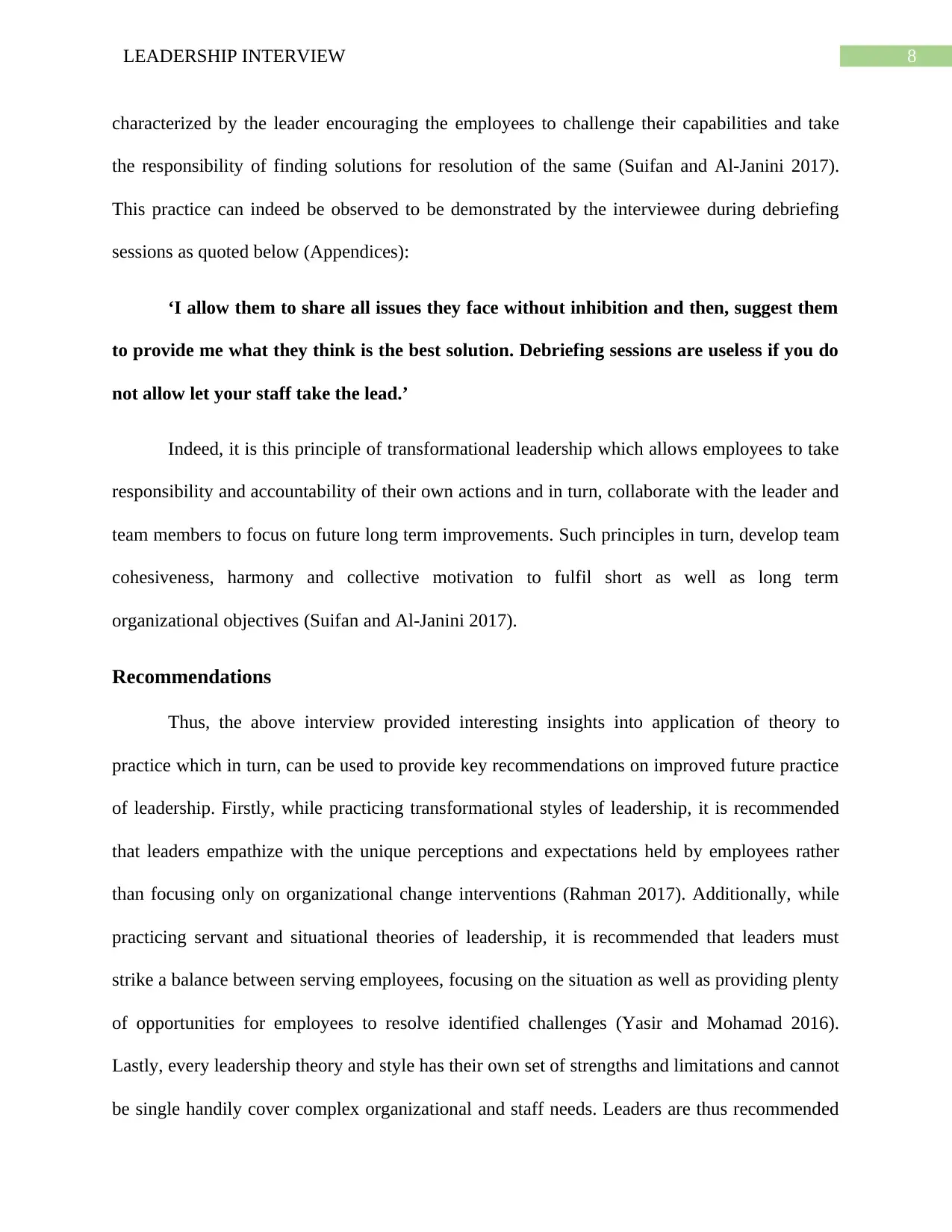
8LEADERSHIP INTERVIEW
characterized by the leader encouraging the employees to challenge their capabilities and take
the responsibility of finding solutions for resolution of the same (Suifan and Al-Janini 2017).
This practice can indeed be observed to be demonstrated by the interviewee during debriefing
sessions as quoted below (Appendices):
‘I allow them to share all issues they face without inhibition and then, suggest them
to provide me what they think is the best solution. Debriefing sessions are useless if you do
not allow let your staff take the lead.’
Indeed, it is this principle of transformational leadership which allows employees to take
responsibility and accountability of their own actions and in turn, collaborate with the leader and
team members to focus on future long term improvements. Such principles in turn, develop team
cohesiveness, harmony and collective motivation to fulfil short as well as long term
organizational objectives (Suifan and Al-Janini 2017).
Recommendations
Thus, the above interview provided interesting insights into application of theory to
practice which in turn, can be used to provide key recommendations on improved future practice
of leadership. Firstly, while practicing transformational styles of leadership, it is recommended
that leaders empathize with the unique perceptions and expectations held by employees rather
than focusing only on organizational change interventions (Rahman 2017). Additionally, while
practicing servant and situational theories of leadership, it is recommended that leaders must
strike a balance between serving employees, focusing on the situation as well as providing plenty
of opportunities for employees to resolve identified challenges (Yasir and Mohamad 2016).
Lastly, every leadership theory and style has their own set of strengths and limitations and cannot
be single handily cover complex organizational and staff needs. Leaders are thus recommended
characterized by the leader encouraging the employees to challenge their capabilities and take
the responsibility of finding solutions for resolution of the same (Suifan and Al-Janini 2017).
This practice can indeed be observed to be demonstrated by the interviewee during debriefing
sessions as quoted below (Appendices):
‘I allow them to share all issues they face without inhibition and then, suggest them
to provide me what they think is the best solution. Debriefing sessions are useless if you do
not allow let your staff take the lead.’
Indeed, it is this principle of transformational leadership which allows employees to take
responsibility and accountability of their own actions and in turn, collaborate with the leader and
team members to focus on future long term improvements. Such principles in turn, develop team
cohesiveness, harmony and collective motivation to fulfil short as well as long term
organizational objectives (Suifan and Al-Janini 2017).
Recommendations
Thus, the above interview provided interesting insights into application of theory to
practice which in turn, can be used to provide key recommendations on improved future practice
of leadership. Firstly, while practicing transformational styles of leadership, it is recommended
that leaders empathize with the unique perceptions and expectations held by employees rather
than focusing only on organizational change interventions (Rahman 2017). Additionally, while
practicing servant and situational theories of leadership, it is recommended that leaders must
strike a balance between serving employees, focusing on the situation as well as providing plenty
of opportunities for employees to resolve identified challenges (Yasir and Mohamad 2016).
Lastly, every leadership theory and style has their own set of strengths and limitations and cannot
be single handily cover complex organizational and staff needs. Leaders are thus recommended
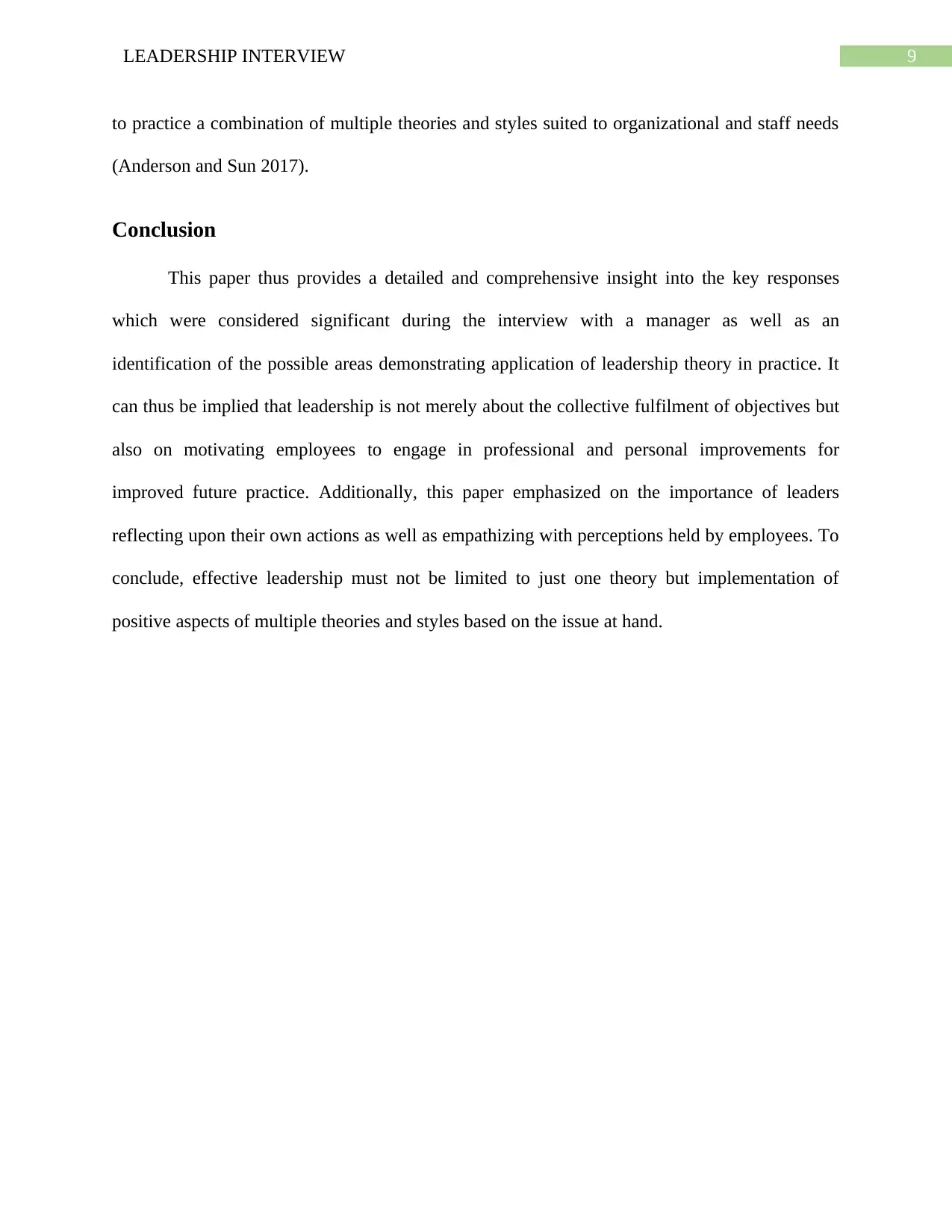
9LEADERSHIP INTERVIEW
to practice a combination of multiple theories and styles suited to organizational and staff needs
(Anderson and Sun 2017).
Conclusion
This paper thus provides a detailed and comprehensive insight into the key responses
which were considered significant during the interview with a manager as well as an
identification of the possible areas demonstrating application of leadership theory in practice. It
can thus be implied that leadership is not merely about the collective fulfilment of objectives but
also on motivating employees to engage in professional and personal improvements for
improved future practice. Additionally, this paper emphasized on the importance of leaders
reflecting upon their own actions as well as empathizing with perceptions held by employees. To
conclude, effective leadership must not be limited to just one theory but implementation of
positive aspects of multiple theories and styles based on the issue at hand.
to practice a combination of multiple theories and styles suited to organizational and staff needs
(Anderson and Sun 2017).
Conclusion
This paper thus provides a detailed and comprehensive insight into the key responses
which were considered significant during the interview with a manager as well as an
identification of the possible areas demonstrating application of leadership theory in practice. It
can thus be implied that leadership is not merely about the collective fulfilment of objectives but
also on motivating employees to engage in professional and personal improvements for
improved future practice. Additionally, this paper emphasized on the importance of leaders
reflecting upon their own actions as well as empathizing with perceptions held by employees. To
conclude, effective leadership must not be limited to just one theory but implementation of
positive aspects of multiple theories and styles based on the issue at hand.
Paraphrase This Document
Need a fresh take? Get an instant paraphrase of this document with our AI Paraphraser
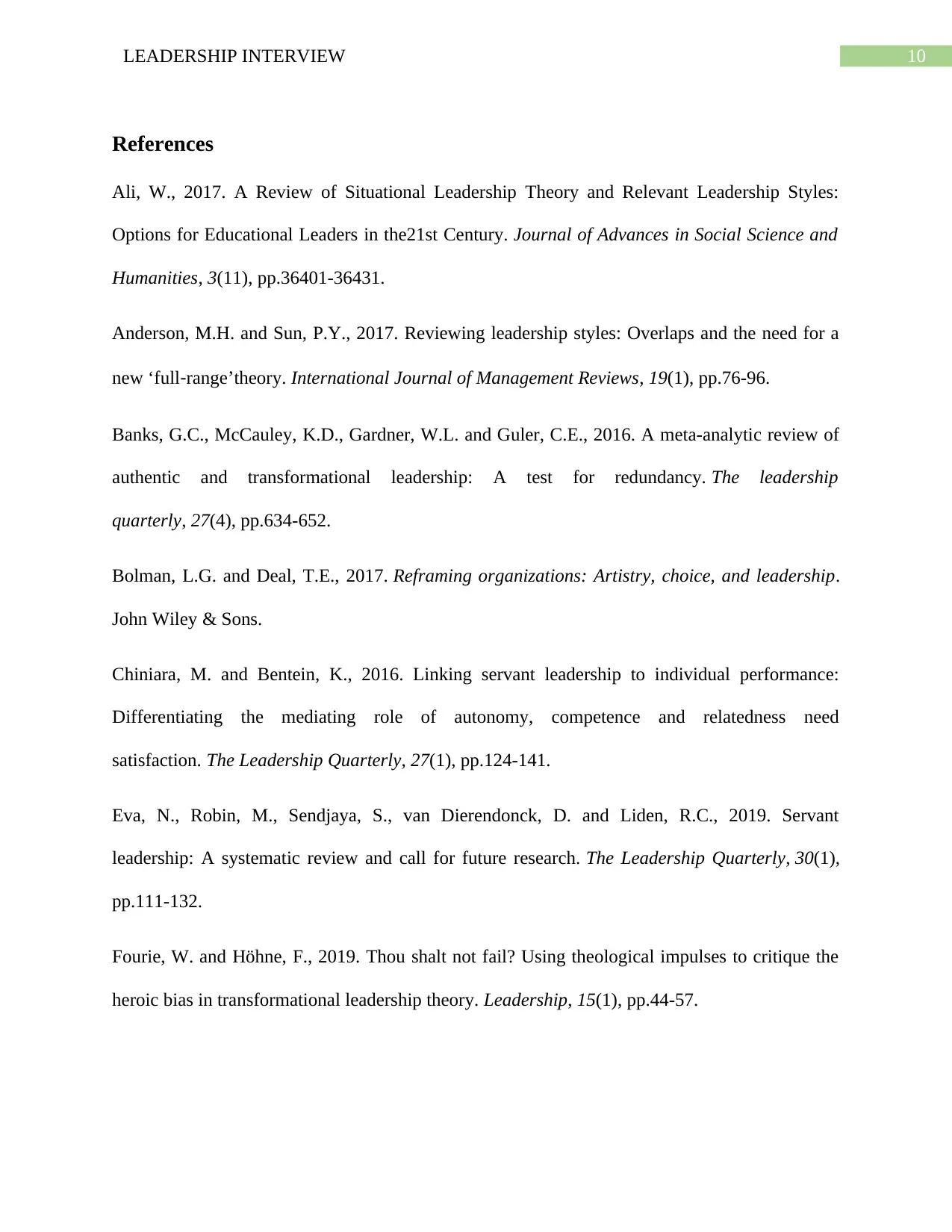
10LEADERSHIP INTERVIEW
References
Ali, W., 2017. A Review of Situational Leadership Theory and Relevant Leadership Styles:
Options for Educational Leaders in the21st Century. Journal of Advances in Social Science and
Humanities, 3(11), pp.36401-36431.
Anderson, M.H. and Sun, P.Y., 2017. Reviewing leadership styles: Overlaps and the need for a
new ‘full‐range’theory. International Journal of Management Reviews, 19(1), pp.76-96.
Banks, G.C., McCauley, K.D., Gardner, W.L. and Guler, C.E., 2016. A meta-analytic review of
authentic and transformational leadership: A test for redundancy. The leadership
quarterly, 27(4), pp.634-652.
Bolman, L.G. and Deal, T.E., 2017. Reframing organizations: Artistry, choice, and leadership.
John Wiley & Sons.
Chiniara, M. and Bentein, K., 2016. Linking servant leadership to individual performance:
Differentiating the mediating role of autonomy, competence and relatedness need
satisfaction. The Leadership Quarterly, 27(1), pp.124-141.
Eva, N., Robin, M., Sendjaya, S., van Dierendonck, D. and Liden, R.C., 2019. Servant
leadership: A systematic review and call for future research. The Leadership Quarterly, 30(1),
pp.111-132.
Fourie, W. and Höhne, F., 2019. Thou shalt not fail? Using theological impulses to critique the
heroic bias in transformational leadership theory. Leadership, 15(1), pp.44-57.
References
Ali, W., 2017. A Review of Situational Leadership Theory and Relevant Leadership Styles:
Options for Educational Leaders in the21st Century. Journal of Advances in Social Science and
Humanities, 3(11), pp.36401-36431.
Anderson, M.H. and Sun, P.Y., 2017. Reviewing leadership styles: Overlaps and the need for a
new ‘full‐range’theory. International Journal of Management Reviews, 19(1), pp.76-96.
Banks, G.C., McCauley, K.D., Gardner, W.L. and Guler, C.E., 2016. A meta-analytic review of
authentic and transformational leadership: A test for redundancy. The leadership
quarterly, 27(4), pp.634-652.
Bolman, L.G. and Deal, T.E., 2017. Reframing organizations: Artistry, choice, and leadership.
John Wiley & Sons.
Chiniara, M. and Bentein, K., 2016. Linking servant leadership to individual performance:
Differentiating the mediating role of autonomy, competence and relatedness need
satisfaction. The Leadership Quarterly, 27(1), pp.124-141.
Eva, N., Robin, M., Sendjaya, S., van Dierendonck, D. and Liden, R.C., 2019. Servant
leadership: A systematic review and call for future research. The Leadership Quarterly, 30(1),
pp.111-132.
Fourie, W. and Höhne, F., 2019. Thou shalt not fail? Using theological impulses to critique the
heroic bias in transformational leadership theory. Leadership, 15(1), pp.44-57.
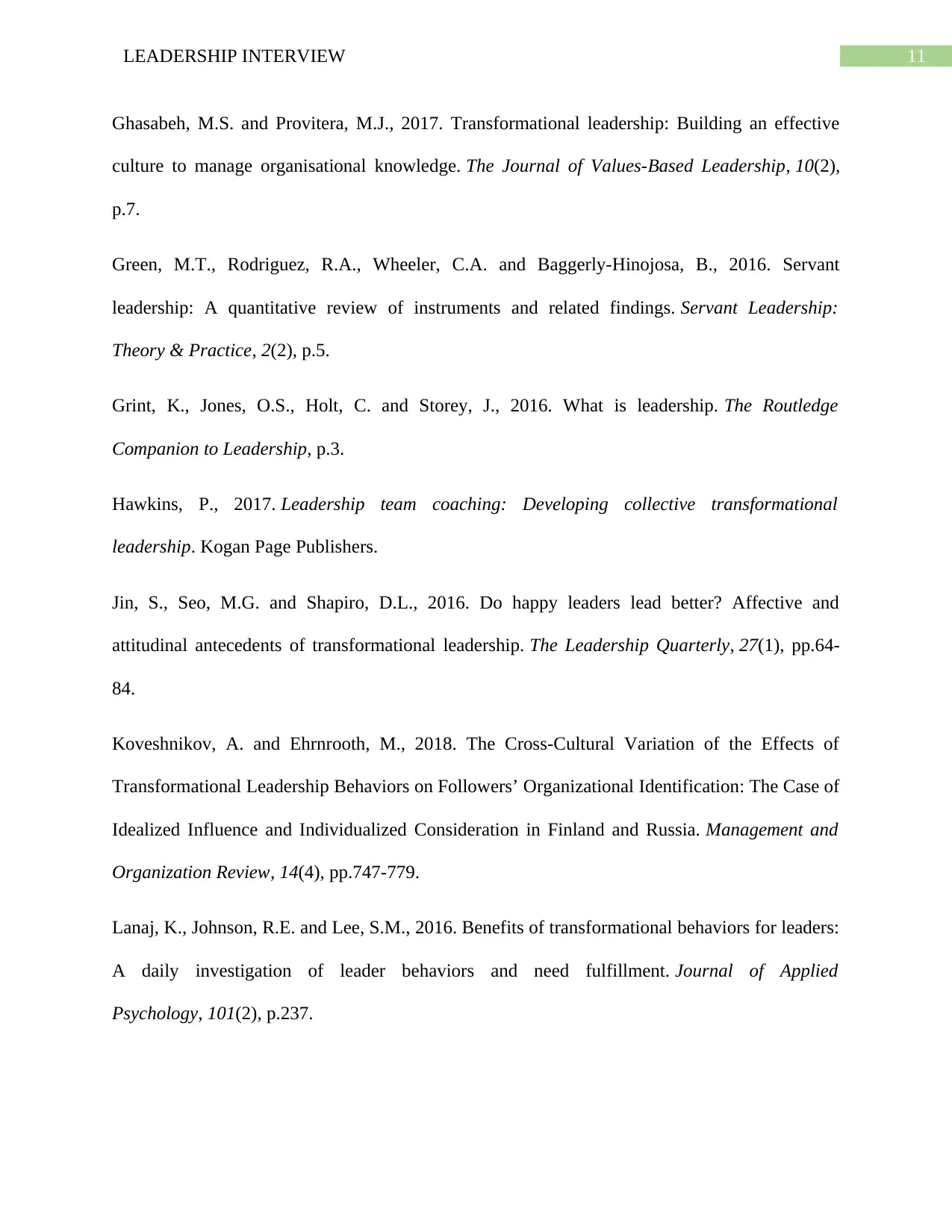
11LEADERSHIP INTERVIEW
Ghasabeh, M.S. and Provitera, M.J., 2017. Transformational leadership: Building an effective
culture to manage organisational knowledge. The Journal of Values-Based Leadership, 10(2),
p.7.
Green, M.T., Rodriguez, R.A., Wheeler, C.A. and Baggerly-Hinojosa, B., 2016. Servant
leadership: A quantitative review of instruments and related findings. Servant Leadership:
Theory & Practice, 2(2), p.5.
Grint, K., Jones, O.S., Holt, C. and Storey, J., 2016. What is leadership. The Routledge
Companion to Leadership, p.3.
Hawkins, P., 2017. Leadership team coaching: Developing collective transformational
leadership. Kogan Page Publishers.
Jin, S., Seo, M.G. and Shapiro, D.L., 2016. Do happy leaders lead better? Affective and
attitudinal antecedents of transformational leadership. The Leadership Quarterly, 27(1), pp.64-
84.
Koveshnikov, A. and Ehrnrooth, M., 2018. The Cross-Cultural Variation of the Effects of
Transformational Leadership Behaviors on Followers’ Organizational Identification: The Case of
Idealized Influence and Individualized Consideration in Finland and Russia. Management and
Organization Review, 14(4), pp.747-779.
Lanaj, K., Johnson, R.E. and Lee, S.M., 2016. Benefits of transformational behaviors for leaders:
A daily investigation of leader behaviors and need fulfillment. Journal of Applied
Psychology, 101(2), p.237.
Ghasabeh, M.S. and Provitera, M.J., 2017. Transformational leadership: Building an effective
culture to manage organisational knowledge. The Journal of Values-Based Leadership, 10(2),
p.7.
Green, M.T., Rodriguez, R.A., Wheeler, C.A. and Baggerly-Hinojosa, B., 2016. Servant
leadership: A quantitative review of instruments and related findings. Servant Leadership:
Theory & Practice, 2(2), p.5.
Grint, K., Jones, O.S., Holt, C. and Storey, J., 2016. What is leadership. The Routledge
Companion to Leadership, p.3.
Hawkins, P., 2017. Leadership team coaching: Developing collective transformational
leadership. Kogan Page Publishers.
Jin, S., Seo, M.G. and Shapiro, D.L., 2016. Do happy leaders lead better? Affective and
attitudinal antecedents of transformational leadership. The Leadership Quarterly, 27(1), pp.64-
84.
Koveshnikov, A. and Ehrnrooth, M., 2018. The Cross-Cultural Variation of the Effects of
Transformational Leadership Behaviors on Followers’ Organizational Identification: The Case of
Idealized Influence and Individualized Consideration in Finland and Russia. Management and
Organization Review, 14(4), pp.747-779.
Lanaj, K., Johnson, R.E. and Lee, S.M., 2016. Benefits of transformational behaviors for leaders:
A daily investigation of leader behaviors and need fulfillment. Journal of Applied
Psychology, 101(2), p.237.
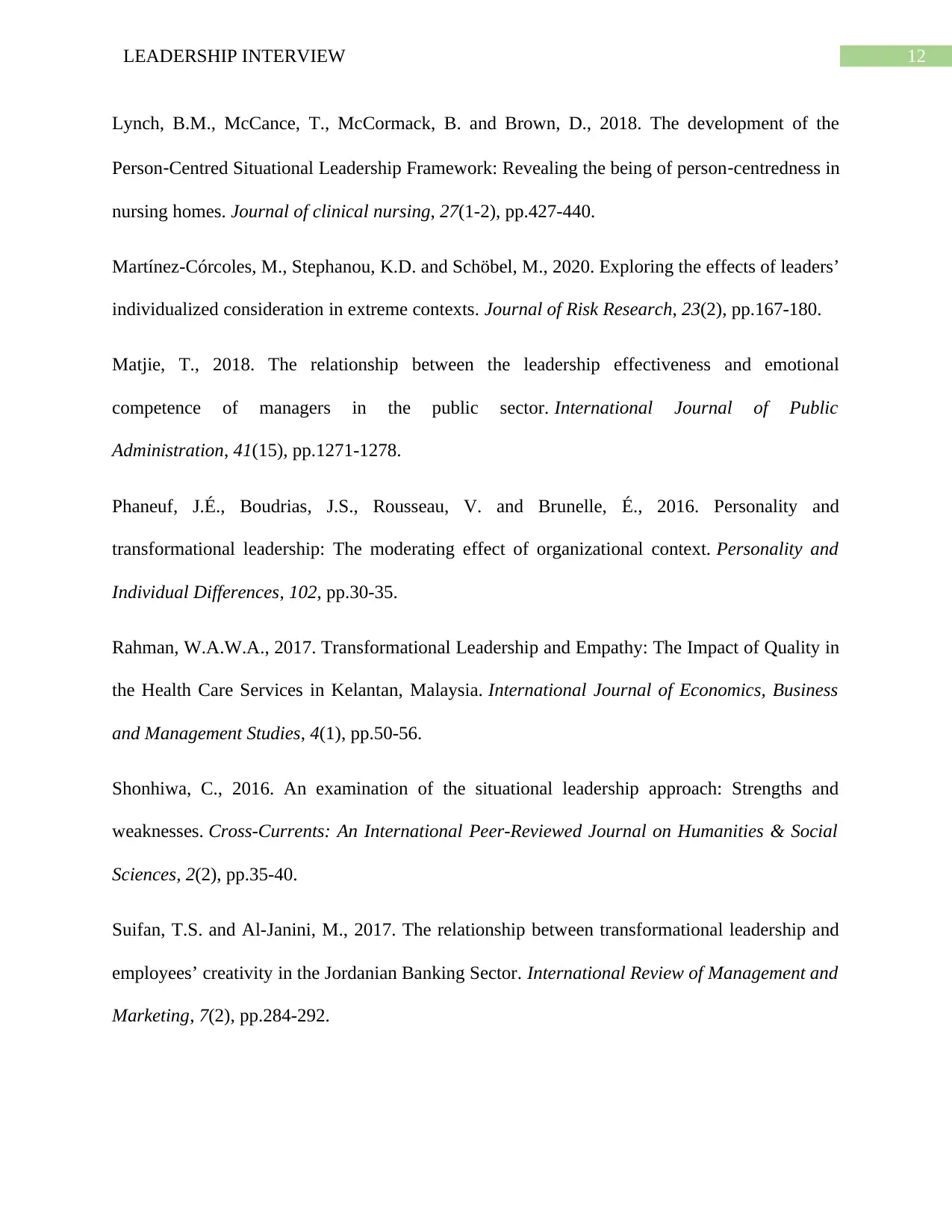
12LEADERSHIP INTERVIEW
Lynch, B.M., McCance, T., McCormack, B. and Brown, D., 2018. The development of the
Person‐Centred Situational Leadership Framework: Revealing the being of person‐centredness in
nursing homes. Journal of clinical nursing, 27(1-2), pp.427-440.
Martínez-Córcoles, M., Stephanou, K.D. and Schöbel, M., 2020. Exploring the effects of leaders’
individualized consideration in extreme contexts. Journal of Risk Research, 23(2), pp.167-180.
Matjie, T., 2018. The relationship between the leadership effectiveness and emotional
competence of managers in the public sector. International Journal of Public
Administration, 41(15), pp.1271-1278.
Phaneuf, J.É., Boudrias, J.S., Rousseau, V. and Brunelle, É., 2016. Personality and
transformational leadership: The moderating effect of organizational context. Personality and
Individual Differences, 102, pp.30-35.
Rahman, W.A.W.A., 2017. Transformational Leadership and Empathy: The Impact of Quality in
the Health Care Services in Kelantan, Malaysia. International Journal of Economics, Business
and Management Studies, 4(1), pp.50-56.
Shonhiwa, C., 2016. An examination of the situational leadership approach: Strengths and
weaknesses. Cross-Currents: An International Peer-Reviewed Journal on Humanities & Social
Sciences, 2(2), pp.35-40.
Suifan, T.S. and Al-Janini, M., 2017. The relationship between transformational leadership and
employees’ creativity in the Jordanian Banking Sector. International Review of Management and
Marketing, 7(2), pp.284-292.
Lynch, B.M., McCance, T., McCormack, B. and Brown, D., 2018. The development of the
Person‐Centred Situational Leadership Framework: Revealing the being of person‐centredness in
nursing homes. Journal of clinical nursing, 27(1-2), pp.427-440.
Martínez-Córcoles, M., Stephanou, K.D. and Schöbel, M., 2020. Exploring the effects of leaders’
individualized consideration in extreme contexts. Journal of Risk Research, 23(2), pp.167-180.
Matjie, T., 2018. The relationship between the leadership effectiveness and emotional
competence of managers in the public sector. International Journal of Public
Administration, 41(15), pp.1271-1278.
Phaneuf, J.É., Boudrias, J.S., Rousseau, V. and Brunelle, É., 2016. Personality and
transformational leadership: The moderating effect of organizational context. Personality and
Individual Differences, 102, pp.30-35.
Rahman, W.A.W.A., 2017. Transformational Leadership and Empathy: The Impact of Quality in
the Health Care Services in Kelantan, Malaysia. International Journal of Economics, Business
and Management Studies, 4(1), pp.50-56.
Shonhiwa, C., 2016. An examination of the situational leadership approach: Strengths and
weaknesses. Cross-Currents: An International Peer-Reviewed Journal on Humanities & Social
Sciences, 2(2), pp.35-40.
Suifan, T.S. and Al-Janini, M., 2017. The relationship between transformational leadership and
employees’ creativity in the Jordanian Banking Sector. International Review of Management and
Marketing, 7(2), pp.284-292.
Secure Best Marks with AI Grader
Need help grading? Try our AI Grader for instant feedback on your assignments.
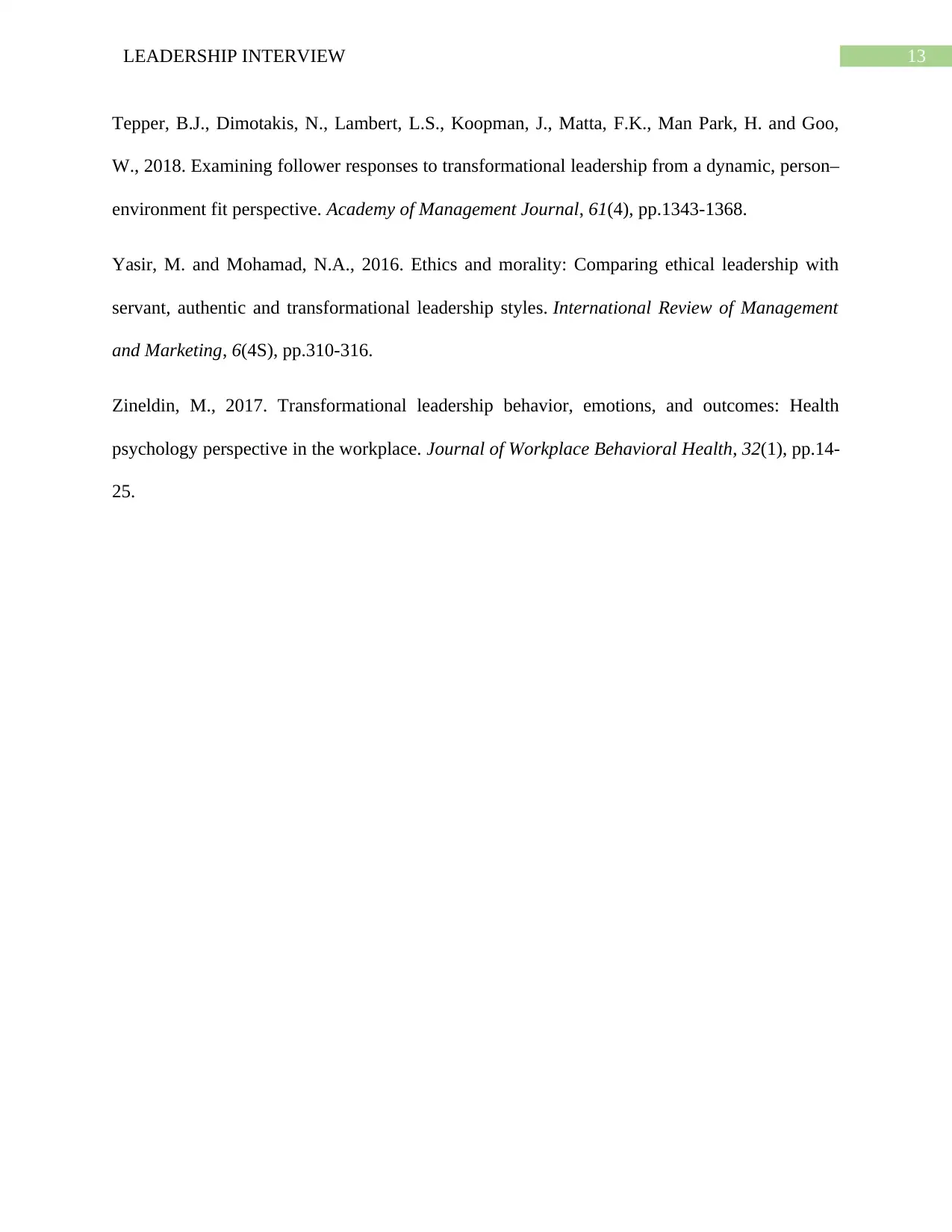
13LEADERSHIP INTERVIEW
Tepper, B.J., Dimotakis, N., Lambert, L.S., Koopman, J., Matta, F.K., Man Park, H. and Goo,
W., 2018. Examining follower responses to transformational leadership from a dynamic, person–
environment fit perspective. Academy of Management Journal, 61(4), pp.1343-1368.
Yasir, M. and Mohamad, N.A., 2016. Ethics and morality: Comparing ethical leadership with
servant, authentic and transformational leadership styles. International Review of Management
and Marketing, 6(4S), pp.310-316.
Zineldin, M., 2017. Transformational leadership behavior, emotions, and outcomes: Health
psychology perspective in the workplace. Journal of Workplace Behavioral Health, 32(1), pp.14-
25.
Tepper, B.J., Dimotakis, N., Lambert, L.S., Koopman, J., Matta, F.K., Man Park, H. and Goo,
W., 2018. Examining follower responses to transformational leadership from a dynamic, person–
environment fit perspective. Academy of Management Journal, 61(4), pp.1343-1368.
Yasir, M. and Mohamad, N.A., 2016. Ethics and morality: Comparing ethical leadership with
servant, authentic and transformational leadership styles. International Review of Management
and Marketing, 6(4S), pp.310-316.
Zineldin, M., 2017. Transformational leadership behavior, emotions, and outcomes: Health
psychology perspective in the workplace. Journal of Workplace Behavioral Health, 32(1), pp.14-
25.
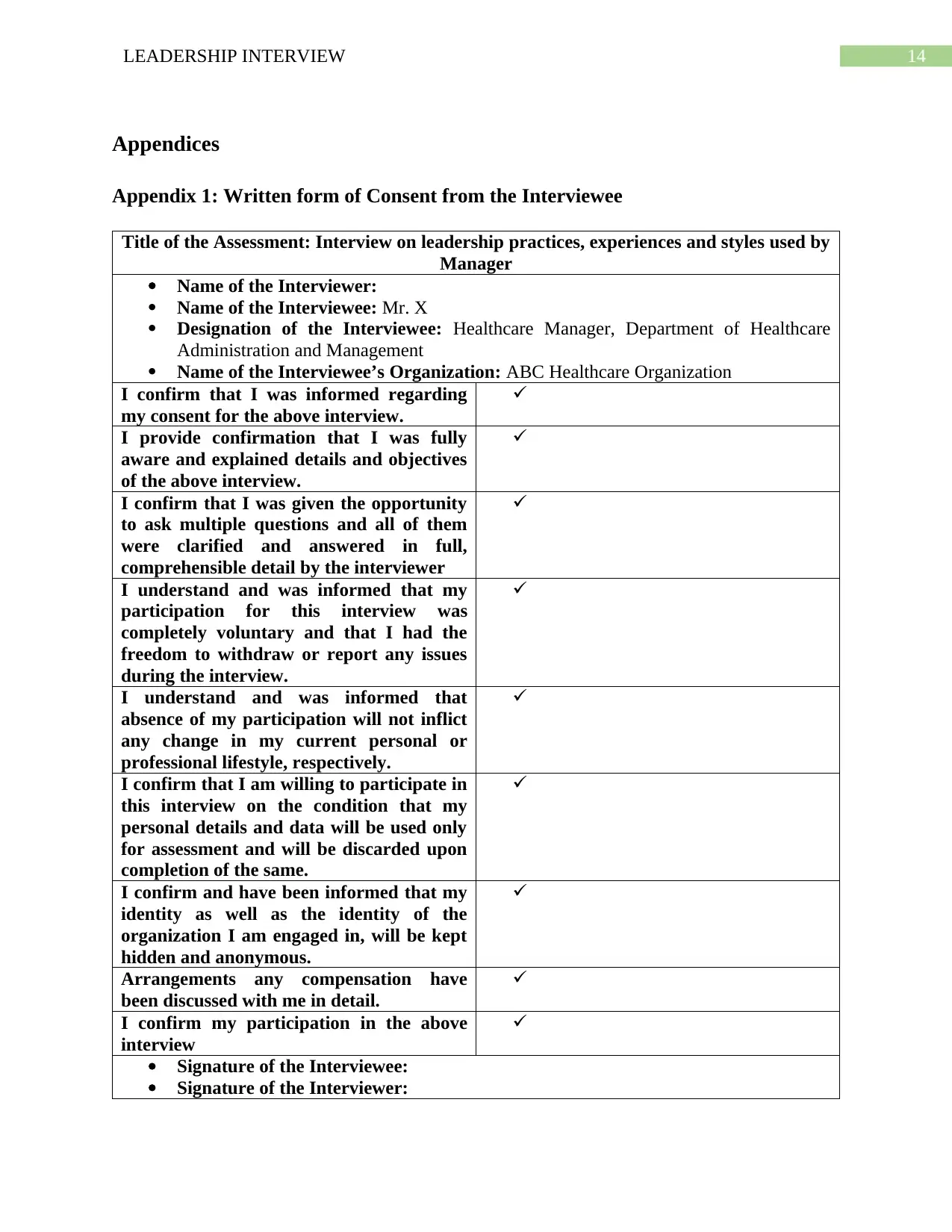
14LEADERSHIP INTERVIEW
Appendices
Appendix 1: Written form of Consent from the Interviewee
Title of the Assessment: Interview on leadership practices, experiences and styles used by
Manager
Name of the Interviewer:
Name of the Interviewee: Mr. X
Designation of the Interviewee: Healthcare Manager, Department of Healthcare
Administration and Management
Name of the Interviewee’s Organization: ABC Healthcare Organization
I confirm that I was informed regarding
my consent for the above interview.
I provide confirmation that I was fully
aware and explained details and objectives
of the above interview.
I confirm that I was given the opportunity
to ask multiple questions and all of them
were clarified and answered in full,
comprehensible detail by the interviewer
I understand and was informed that my
participation for this interview was
completely voluntary and that I had the
freedom to withdraw or report any issues
during the interview.
I understand and was informed that
absence of my participation will not inflict
any change in my current personal or
professional lifestyle, respectively.
I confirm that I am willing to participate in
this interview on the condition that my
personal details and data will be used only
for assessment and will be discarded upon
completion of the same.
I confirm and have been informed that my
identity as well as the identity of the
organization I am engaged in, will be kept
hidden and anonymous.
Arrangements any compensation have
been discussed with me in detail.
I confirm my participation in the above
interview
Signature of the Interviewee:
Signature of the Interviewer:
Appendices
Appendix 1: Written form of Consent from the Interviewee
Title of the Assessment: Interview on leadership practices, experiences and styles used by
Manager
Name of the Interviewer:
Name of the Interviewee: Mr. X
Designation of the Interviewee: Healthcare Manager, Department of Healthcare
Administration and Management
Name of the Interviewee’s Organization: ABC Healthcare Organization
I confirm that I was informed regarding
my consent for the above interview.
I provide confirmation that I was fully
aware and explained details and objectives
of the above interview.
I confirm that I was given the opportunity
to ask multiple questions and all of them
were clarified and answered in full,
comprehensible detail by the interviewer
I understand and was informed that my
participation for this interview was
completely voluntary and that I had the
freedom to withdraw or report any issues
during the interview.
I understand and was informed that
absence of my participation will not inflict
any change in my current personal or
professional lifestyle, respectively.
I confirm that I am willing to participate in
this interview on the condition that my
personal details and data will be used only
for assessment and will be discarded upon
completion of the same.
I confirm and have been informed that my
identity as well as the identity of the
organization I am engaged in, will be kept
hidden and anonymous.
Arrangements any compensation have
been discussed with me in detail.
I confirm my participation in the above
interview
Signature of the Interviewee:
Signature of the Interviewer:
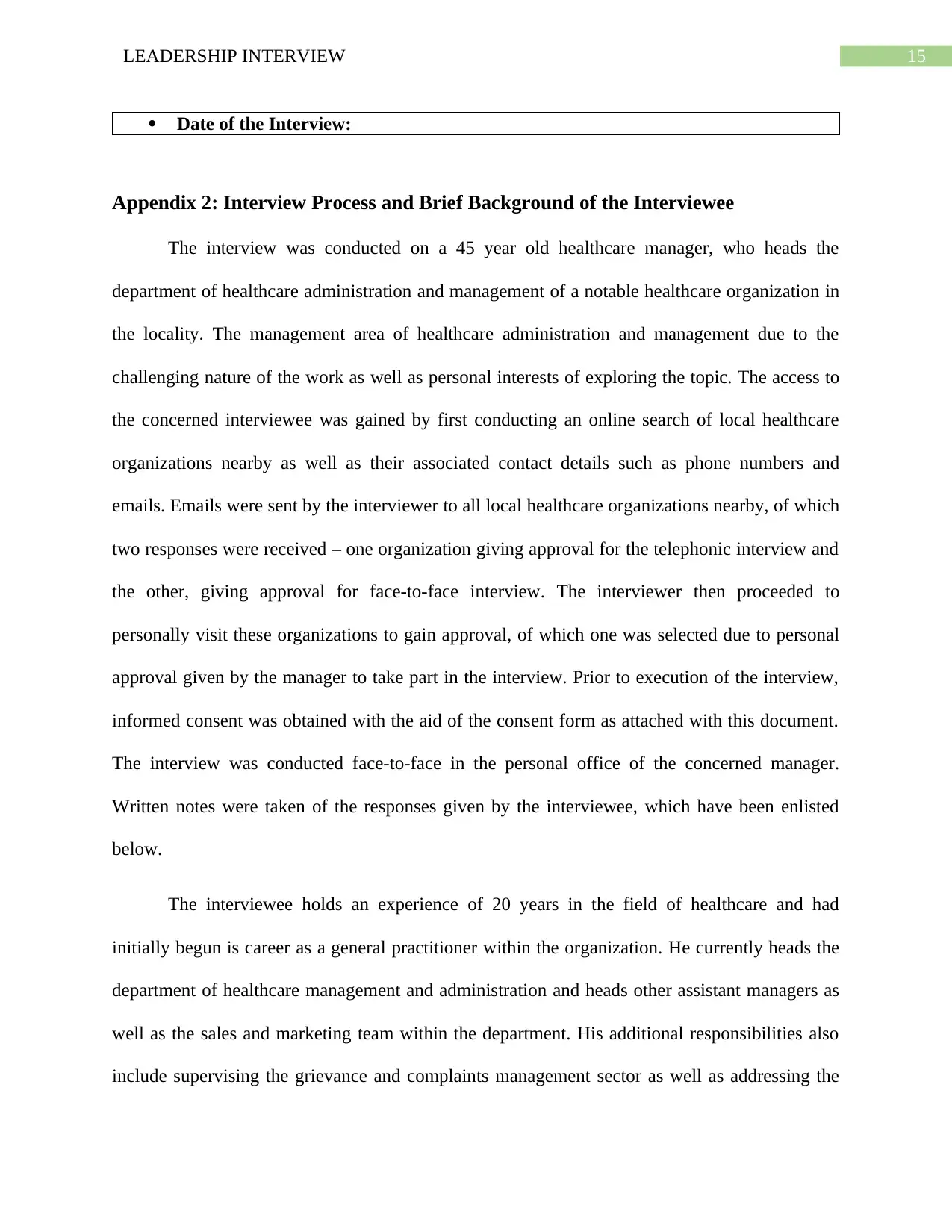
15LEADERSHIP INTERVIEW
Date of the Interview:
Appendix 2: Interview Process and Brief Background of the Interviewee
The interview was conducted on a 45 year old healthcare manager, who heads the
department of healthcare administration and management of a notable healthcare organization in
the locality. The management area of healthcare administration and management due to the
challenging nature of the work as well as personal interests of exploring the topic. The access to
the concerned interviewee was gained by first conducting an online search of local healthcare
organizations nearby as well as their associated contact details such as phone numbers and
emails. Emails were sent by the interviewer to all local healthcare organizations nearby, of which
two responses were received – one organization giving approval for the telephonic interview and
the other, giving approval for face-to-face interview. The interviewer then proceeded to
personally visit these organizations to gain approval, of which one was selected due to personal
approval given by the manager to take part in the interview. Prior to execution of the interview,
informed consent was obtained with the aid of the consent form as attached with this document.
The interview was conducted face-to-face in the personal office of the concerned manager.
Written notes were taken of the responses given by the interviewee, which have been enlisted
below.
The interviewee holds an experience of 20 years in the field of healthcare and had
initially begun is career as a general practitioner within the organization. He currently heads the
department of healthcare management and administration and heads other assistant managers as
well as the sales and marketing team within the department. His additional responsibilities also
include supervising the grievance and complaints management sector as well as addressing the
Date of the Interview:
Appendix 2: Interview Process and Brief Background of the Interviewee
The interview was conducted on a 45 year old healthcare manager, who heads the
department of healthcare administration and management of a notable healthcare organization in
the locality. The management area of healthcare administration and management due to the
challenging nature of the work as well as personal interests of exploring the topic. The access to
the concerned interviewee was gained by first conducting an online search of local healthcare
organizations nearby as well as their associated contact details such as phone numbers and
emails. Emails were sent by the interviewer to all local healthcare organizations nearby, of which
two responses were received – one organization giving approval for the telephonic interview and
the other, giving approval for face-to-face interview. The interviewer then proceeded to
personally visit these organizations to gain approval, of which one was selected due to personal
approval given by the manager to take part in the interview. Prior to execution of the interview,
informed consent was obtained with the aid of the consent form as attached with this document.
The interview was conducted face-to-face in the personal office of the concerned manager.
Written notes were taken of the responses given by the interviewee, which have been enlisted
below.
The interviewee holds an experience of 20 years in the field of healthcare and had
initially begun is career as a general practitioner within the organization. He currently heads the
department of healthcare management and administration and heads other assistant managers as
well as the sales and marketing team within the department. His additional responsibilities also
include supervising the grievance and complaints management sector as well as addressing the
Paraphrase This Document
Need a fresh take? Get an instant paraphrase of this document with our AI Paraphraser
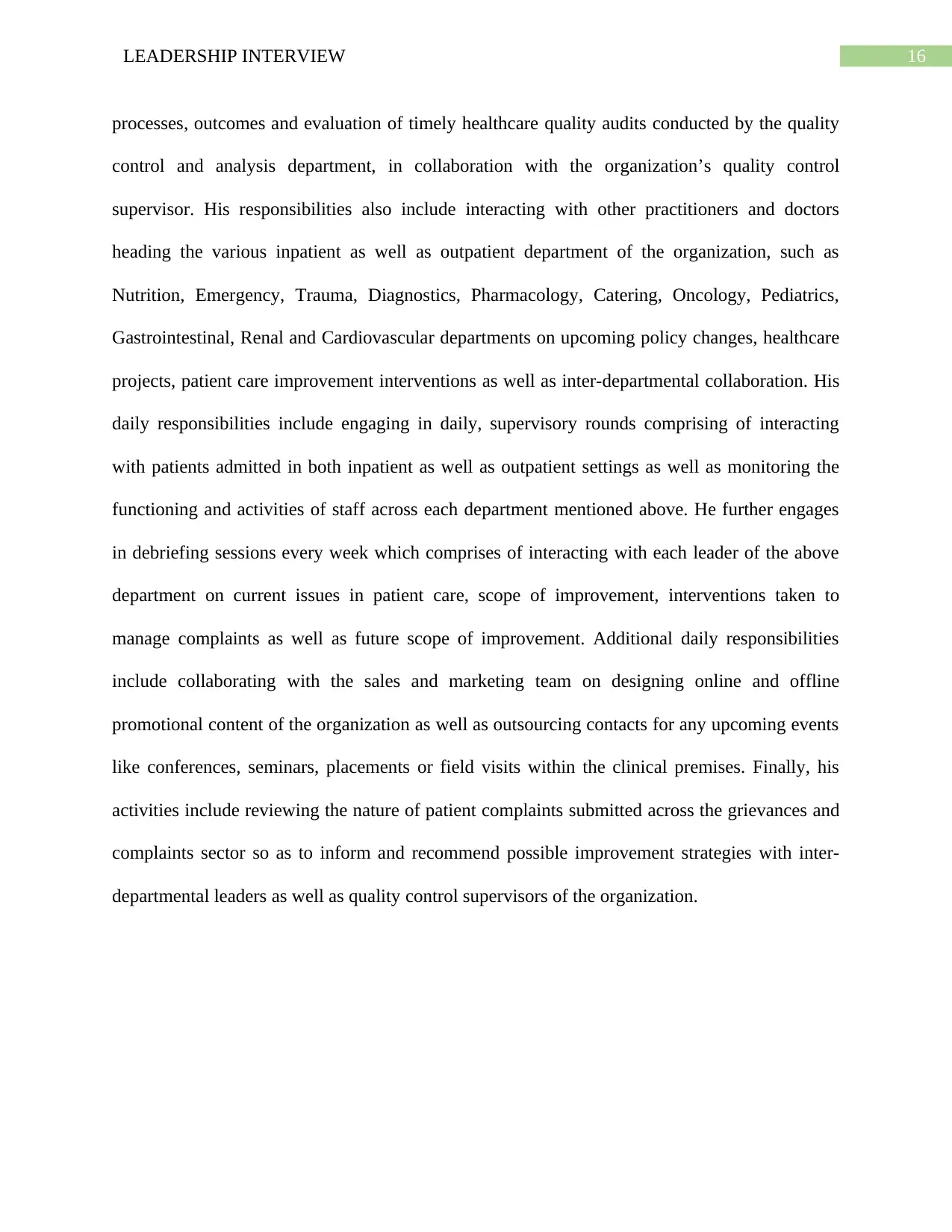
16LEADERSHIP INTERVIEW
processes, outcomes and evaluation of timely healthcare quality audits conducted by the quality
control and analysis department, in collaboration with the organization’s quality control
supervisor. His responsibilities also include interacting with other practitioners and doctors
heading the various inpatient as well as outpatient department of the organization, such as
Nutrition, Emergency, Trauma, Diagnostics, Pharmacology, Catering, Oncology, Pediatrics,
Gastrointestinal, Renal and Cardiovascular departments on upcoming policy changes, healthcare
projects, patient care improvement interventions as well as inter-departmental collaboration. His
daily responsibilities include engaging in daily, supervisory rounds comprising of interacting
with patients admitted in both inpatient as well as outpatient settings as well as monitoring the
functioning and activities of staff across each department mentioned above. He further engages
in debriefing sessions every week which comprises of interacting with each leader of the above
department on current issues in patient care, scope of improvement, interventions taken to
manage complaints as well as future scope of improvement. Additional daily responsibilities
include collaborating with the sales and marketing team on designing online and offline
promotional content of the organization as well as outsourcing contacts for any upcoming events
like conferences, seminars, placements or field visits within the clinical premises. Finally, his
activities include reviewing the nature of patient complaints submitted across the grievances and
complaints sector so as to inform and recommend possible improvement strategies with inter-
departmental leaders as well as quality control supervisors of the organization.
processes, outcomes and evaluation of timely healthcare quality audits conducted by the quality
control and analysis department, in collaboration with the organization’s quality control
supervisor. His responsibilities also include interacting with other practitioners and doctors
heading the various inpatient as well as outpatient department of the organization, such as
Nutrition, Emergency, Trauma, Diagnostics, Pharmacology, Catering, Oncology, Pediatrics,
Gastrointestinal, Renal and Cardiovascular departments on upcoming policy changes, healthcare
projects, patient care improvement interventions as well as inter-departmental collaboration. His
daily responsibilities include engaging in daily, supervisory rounds comprising of interacting
with patients admitted in both inpatient as well as outpatient settings as well as monitoring the
functioning and activities of staff across each department mentioned above. He further engages
in debriefing sessions every week which comprises of interacting with each leader of the above
department on current issues in patient care, scope of improvement, interventions taken to
manage complaints as well as future scope of improvement. Additional daily responsibilities
include collaborating with the sales and marketing team on designing online and offline
promotional content of the organization as well as outsourcing contacts for any upcoming events
like conferences, seminars, placements or field visits within the clinical premises. Finally, his
activities include reviewing the nature of patient complaints submitted across the grievances and
complaints sector so as to inform and recommend possible improvement strategies with inter-
departmental leaders as well as quality control supervisors of the organization.
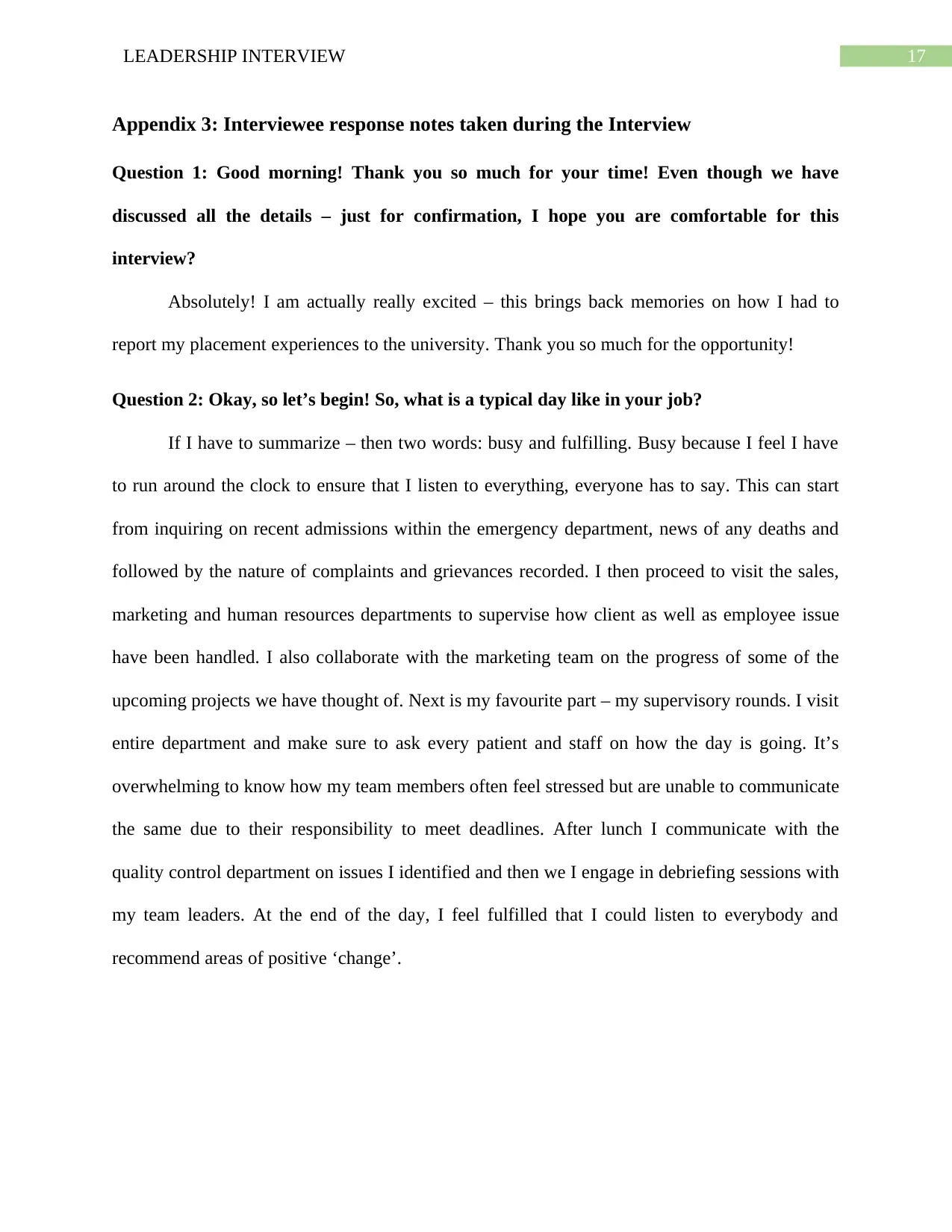
17LEADERSHIP INTERVIEW
Appendix 3: Interviewee response notes taken during the Interview
Question 1: Good morning! Thank you so much for your time! Even though we have
discussed all the details – just for confirmation, I hope you are comfortable for this
interview?
Absolutely! I am actually really excited – this brings back memories on how I had to
report my placement experiences to the university. Thank you so much for the opportunity!
Question 2: Okay, so let’s begin! So, what is a typical day like in your job?
If I have to summarize – then two words: busy and fulfilling. Busy because I feel I have
to run around the clock to ensure that I listen to everything, everyone has to say. This can start
from inquiring on recent admissions within the emergency department, news of any deaths and
followed by the nature of complaints and grievances recorded. I then proceed to visit the sales,
marketing and human resources departments to supervise how client as well as employee issue
have been handled. I also collaborate with the marketing team on the progress of some of the
upcoming projects we have thought of. Next is my favourite part – my supervisory rounds. I visit
entire department and make sure to ask every patient and staff on how the day is going. It’s
overwhelming to know how my team members often feel stressed but are unable to communicate
the same due to their responsibility to meet deadlines. After lunch I communicate with the
quality control department on issues I identified and then we I engage in debriefing sessions with
my team leaders. At the end of the day, I feel fulfilled that I could listen to everybody and
recommend areas of positive ‘change’.
Appendix 3: Interviewee response notes taken during the Interview
Question 1: Good morning! Thank you so much for your time! Even though we have
discussed all the details – just for confirmation, I hope you are comfortable for this
interview?
Absolutely! I am actually really excited – this brings back memories on how I had to
report my placement experiences to the university. Thank you so much for the opportunity!
Question 2: Okay, so let’s begin! So, what is a typical day like in your job?
If I have to summarize – then two words: busy and fulfilling. Busy because I feel I have
to run around the clock to ensure that I listen to everything, everyone has to say. This can start
from inquiring on recent admissions within the emergency department, news of any deaths and
followed by the nature of complaints and grievances recorded. I then proceed to visit the sales,
marketing and human resources departments to supervise how client as well as employee issue
have been handled. I also collaborate with the marketing team on the progress of some of the
upcoming projects we have thought of. Next is my favourite part – my supervisory rounds. I visit
entire department and make sure to ask every patient and staff on how the day is going. It’s
overwhelming to know how my team members often feel stressed but are unable to communicate
the same due to their responsibility to meet deadlines. After lunch I communicate with the
quality control department on issues I identified and then we I engage in debriefing sessions with
my team leaders. At the end of the day, I feel fulfilled that I could listen to everybody and
recommend areas of positive ‘change’.
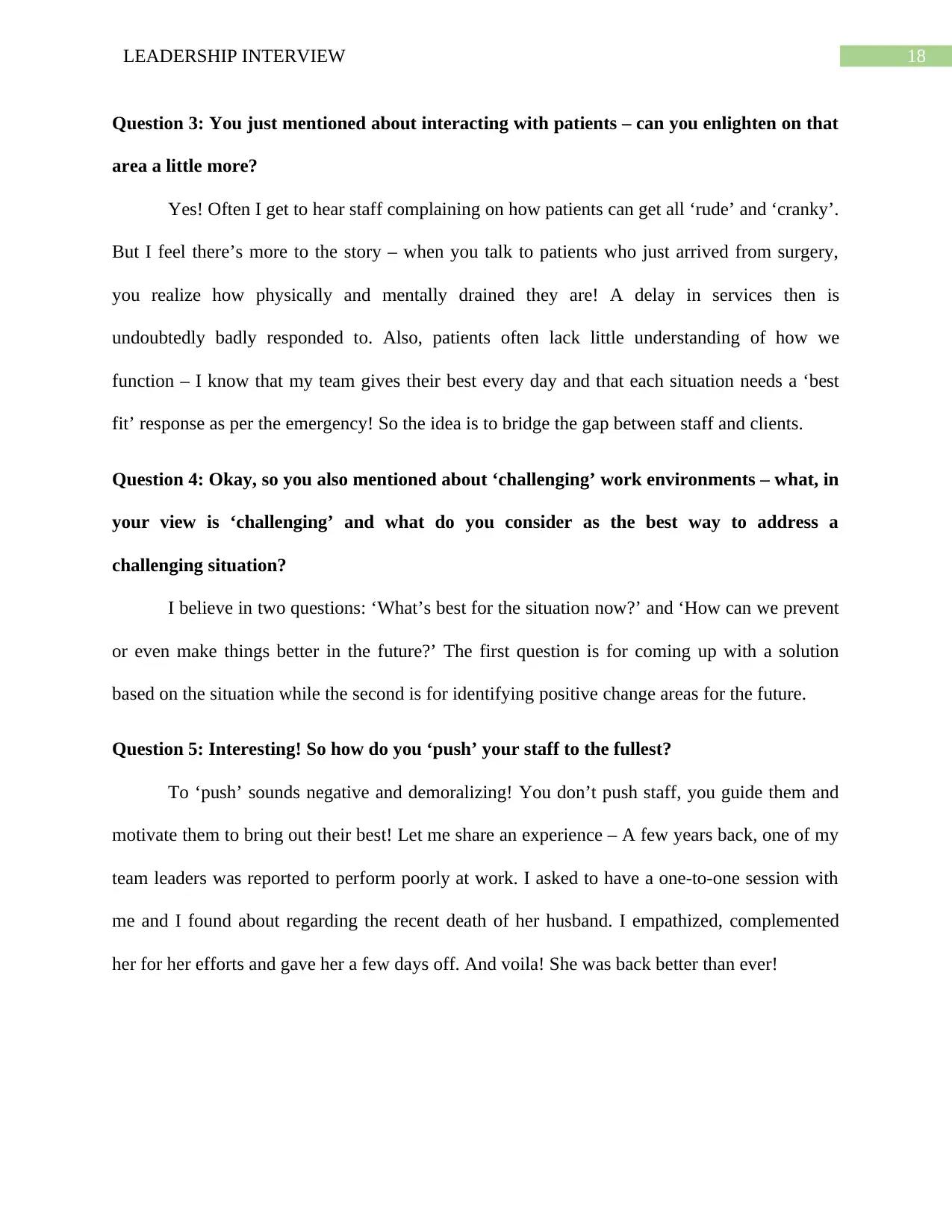
18LEADERSHIP INTERVIEW
Question 3: You just mentioned about interacting with patients – can you enlighten on that
area a little more?
Yes! Often I get to hear staff complaining on how patients can get all ‘rude’ and ‘cranky’.
But I feel there’s more to the story – when you talk to patients who just arrived from surgery,
you realize how physically and mentally drained they are! A delay in services then is
undoubtedly badly responded to. Also, patients often lack little understanding of how we
function – I know that my team gives their best every day and that each situation needs a ‘best
fit’ response as per the emergency! So the idea is to bridge the gap between staff and clients.
Question 4: Okay, so you also mentioned about ‘challenging’ work environments – what, in
your view is ‘challenging’ and what do you consider as the best way to address a
challenging situation?
I believe in two questions: ‘What’s best for the situation now?’ and ‘How can we prevent
or even make things better in the future?’ The first question is for coming up with a solution
based on the situation while the second is for identifying positive change areas for the future.
Question 5: Interesting! So how do you ‘push’ your staff to the fullest?
To ‘push’ sounds negative and demoralizing! You don’t push staff, you guide them and
motivate them to bring out their best! Let me share an experience – A few years back, one of my
team leaders was reported to perform poorly at work. I asked to have a one-to-one session with
me and I found about regarding the recent death of her husband. I empathized, complemented
her for her efforts and gave her a few days off. And voila! She was back better than ever!
Question 3: You just mentioned about interacting with patients – can you enlighten on that
area a little more?
Yes! Often I get to hear staff complaining on how patients can get all ‘rude’ and ‘cranky’.
But I feel there’s more to the story – when you talk to patients who just arrived from surgery,
you realize how physically and mentally drained they are! A delay in services then is
undoubtedly badly responded to. Also, patients often lack little understanding of how we
function – I know that my team gives their best every day and that each situation needs a ‘best
fit’ response as per the emergency! So the idea is to bridge the gap between staff and clients.
Question 4: Okay, so you also mentioned about ‘challenging’ work environments – what, in
your view is ‘challenging’ and what do you consider as the best way to address a
challenging situation?
I believe in two questions: ‘What’s best for the situation now?’ and ‘How can we prevent
or even make things better in the future?’ The first question is for coming up with a solution
based on the situation while the second is for identifying positive change areas for the future.
Question 5: Interesting! So how do you ‘push’ your staff to the fullest?
To ‘push’ sounds negative and demoralizing! You don’t push staff, you guide them and
motivate them to bring out their best! Let me share an experience – A few years back, one of my
team leaders was reported to perform poorly at work. I asked to have a one-to-one session with
me and I found about regarding the recent death of her husband. I empathized, complemented
her for her efforts and gave her a few days off. And voila! She was back better than ever!
Secure Best Marks with AI Grader
Need help grading? Try our AI Grader for instant feedback on your assignments.
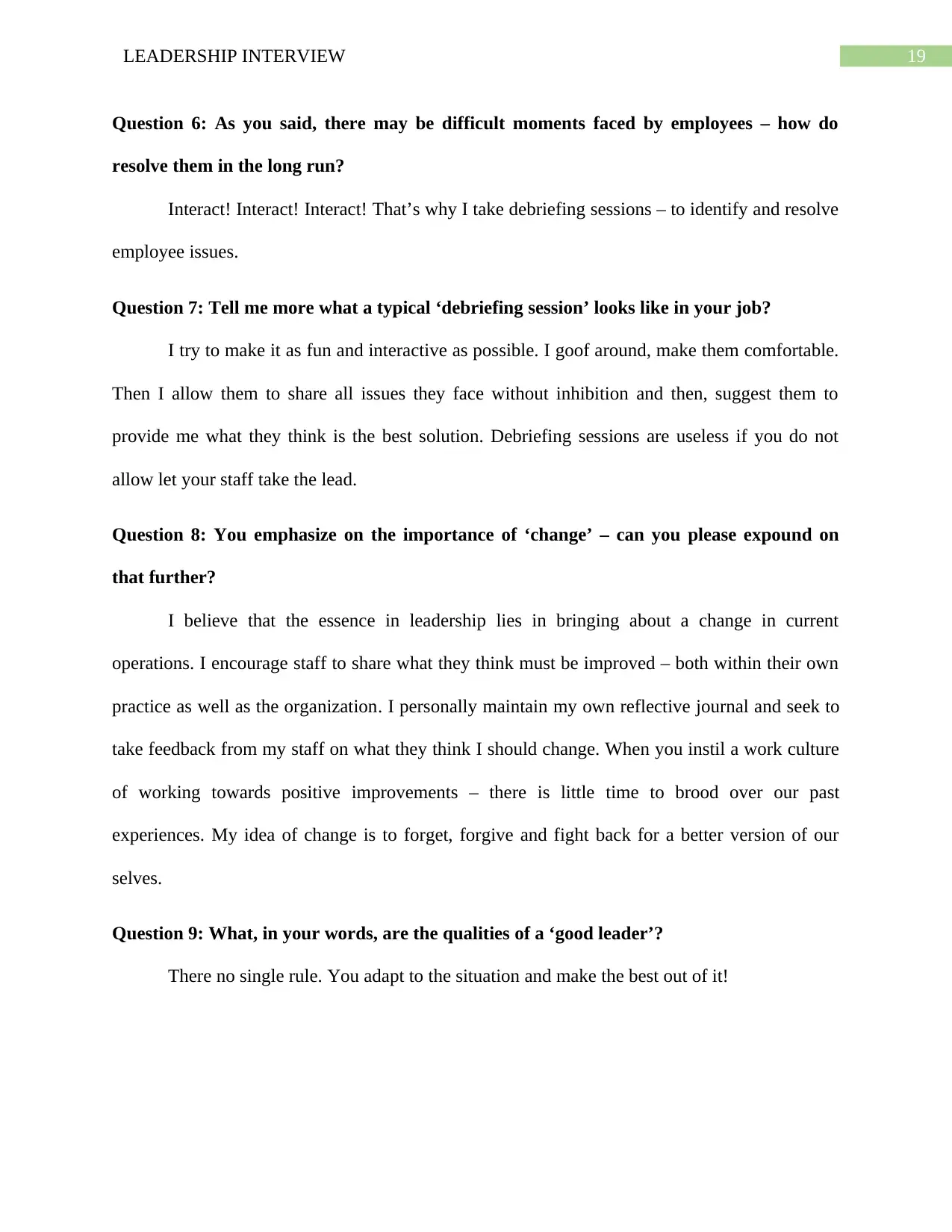
19LEADERSHIP INTERVIEW
Question 6: As you said, there may be difficult moments faced by employees – how do
resolve them in the long run?
Interact! Interact! Interact! That’s why I take debriefing sessions – to identify and resolve
employee issues.
Question 7: Tell me more what a typical ‘debriefing session’ looks like in your job?
I try to make it as fun and interactive as possible. I goof around, make them comfortable.
Then I allow them to share all issues they face without inhibition and then, suggest them to
provide me what they think is the best solution. Debriefing sessions are useless if you do not
allow let your staff take the lead.
Question 8: You emphasize on the importance of ‘change’ – can you please expound on
that further?
I believe that the essence in leadership lies in bringing about a change in current
operations. I encourage staff to share what they think must be improved – both within their own
practice as well as the organization. I personally maintain my own reflective journal and seek to
take feedback from my staff on what they think I should change. When you instil a work culture
of working towards positive improvements – there is little time to brood over our past
experiences. My idea of change is to forget, forgive and fight back for a better version of our
selves.
Question 9: What, in your words, are the qualities of a ‘good leader’?
There no single rule. You adapt to the situation and make the best out of it!
Question 6: As you said, there may be difficult moments faced by employees – how do
resolve them in the long run?
Interact! Interact! Interact! That’s why I take debriefing sessions – to identify and resolve
employee issues.
Question 7: Tell me more what a typical ‘debriefing session’ looks like in your job?
I try to make it as fun and interactive as possible. I goof around, make them comfortable.
Then I allow them to share all issues they face without inhibition and then, suggest them to
provide me what they think is the best solution. Debriefing sessions are useless if you do not
allow let your staff take the lead.
Question 8: You emphasize on the importance of ‘change’ – can you please expound on
that further?
I believe that the essence in leadership lies in bringing about a change in current
operations. I encourage staff to share what they think must be improved – both within their own
practice as well as the organization. I personally maintain my own reflective journal and seek to
take feedback from my staff on what they think I should change. When you instil a work culture
of working towards positive improvements – there is little time to brood over our past
experiences. My idea of change is to forget, forgive and fight back for a better version of our
selves.
Question 9: What, in your words, are the qualities of a ‘good leader’?
There no single rule. You adapt to the situation and make the best out of it!
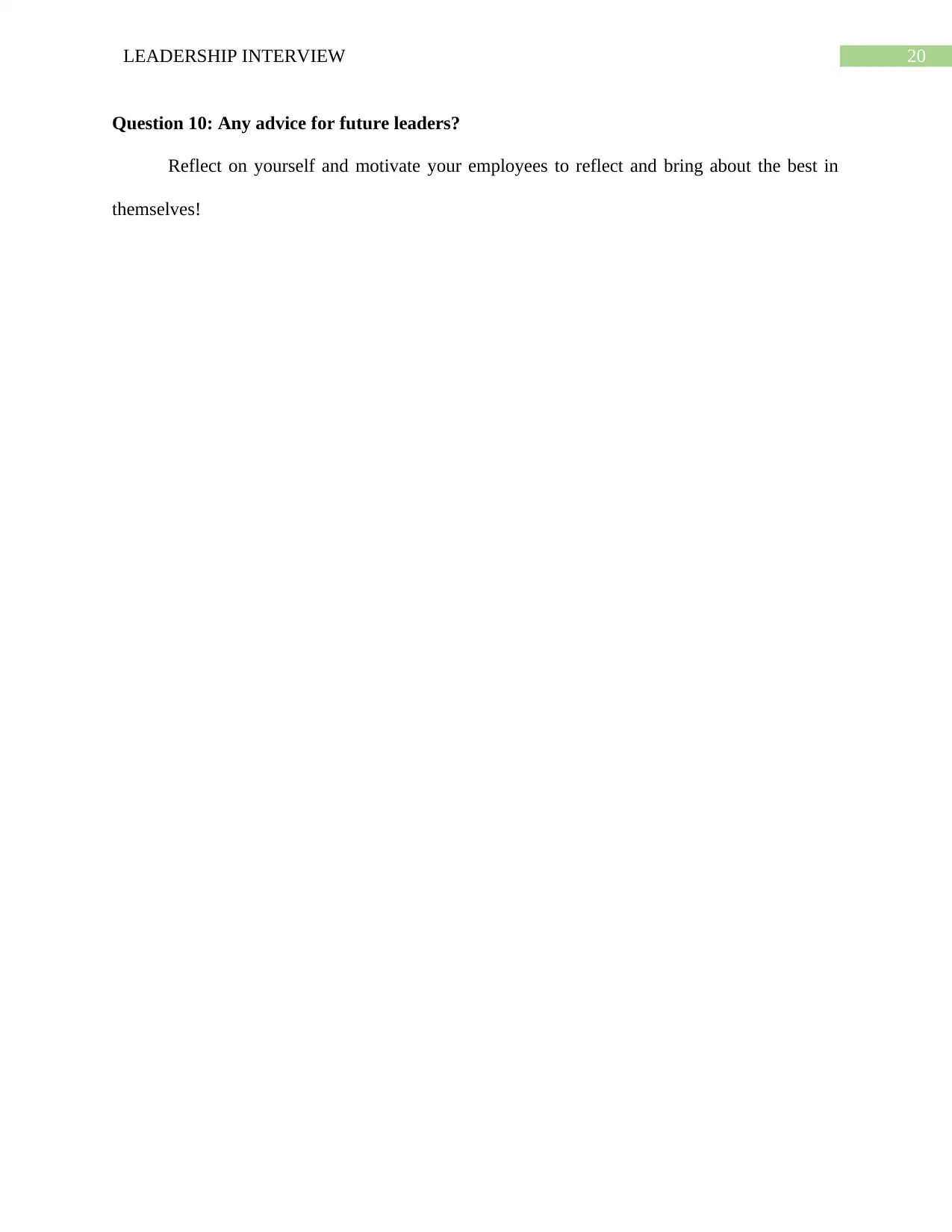
20LEADERSHIP INTERVIEW
Question 10: Any advice for future leaders?
Reflect on yourself and motivate your employees to reflect and bring about the best in
themselves!
Question 10: Any advice for future leaders?
Reflect on yourself and motivate your employees to reflect and bring about the best in
themselves!
1 out of 21
![[object Object]](/_next/static/media/star-bottom.7253800d.svg)





